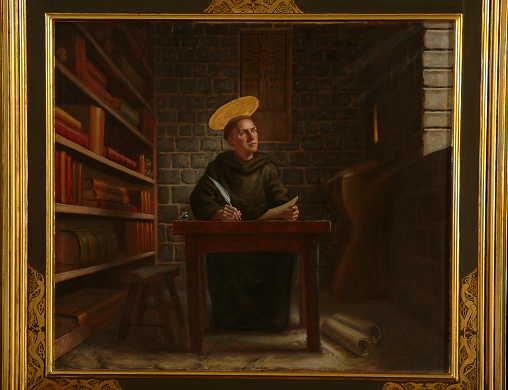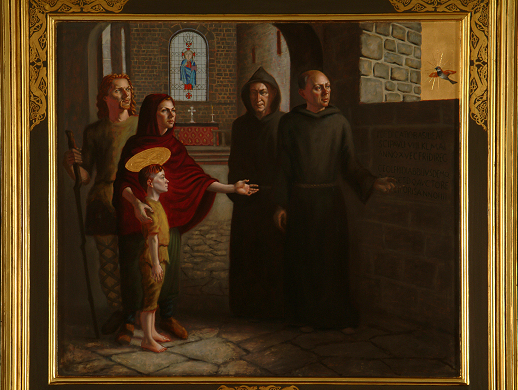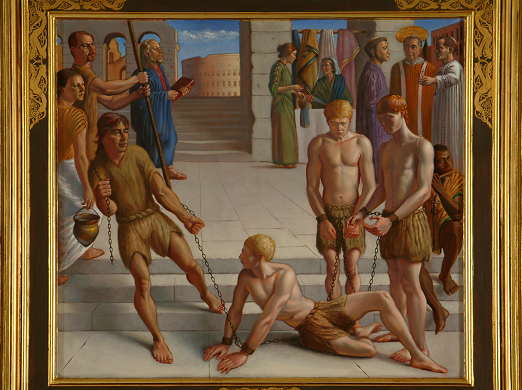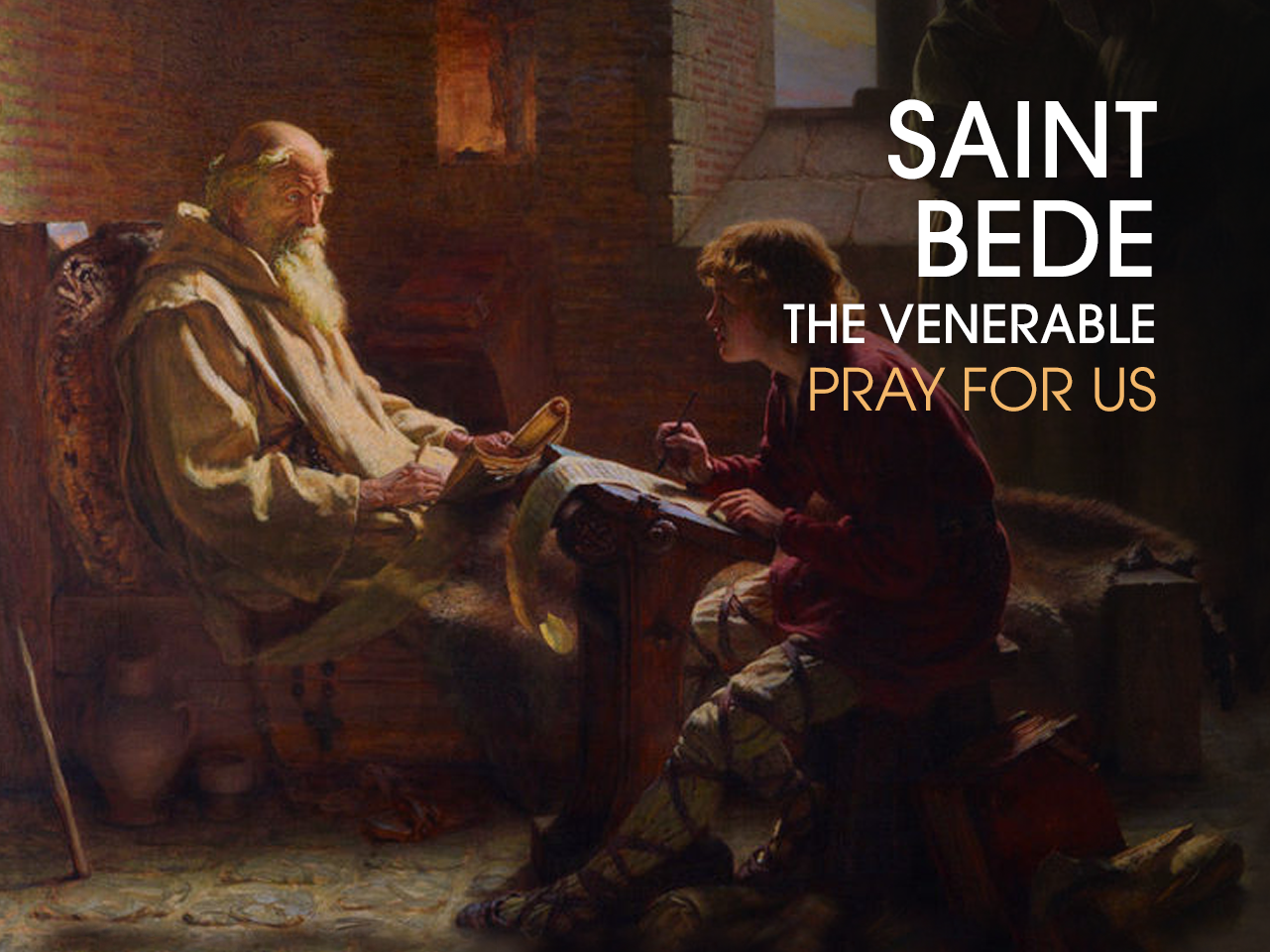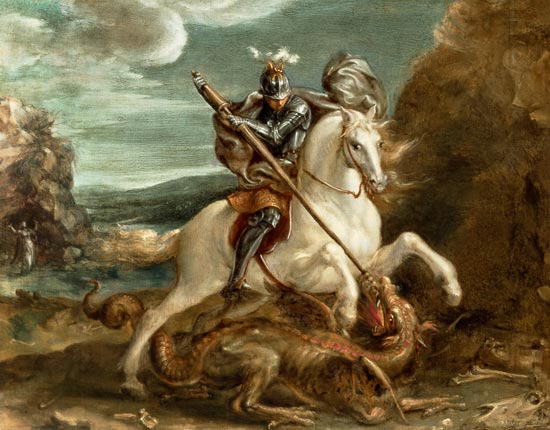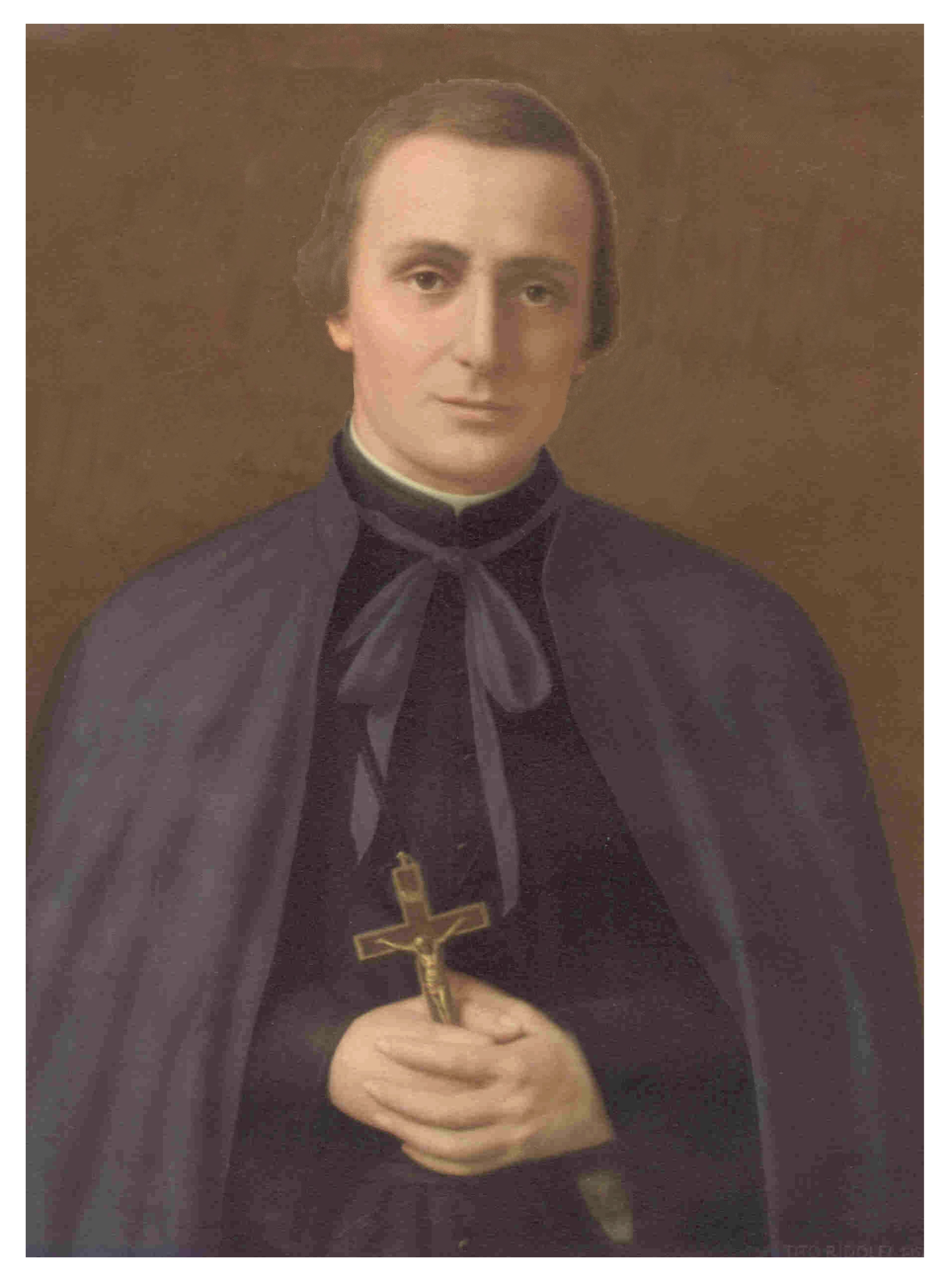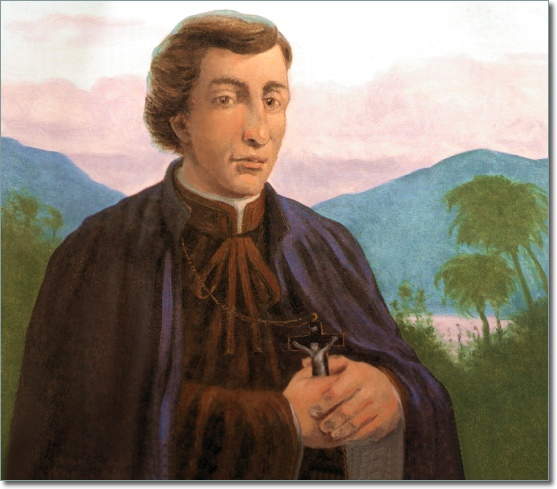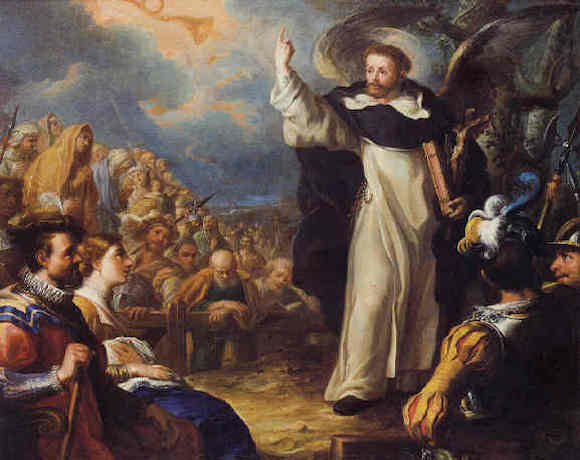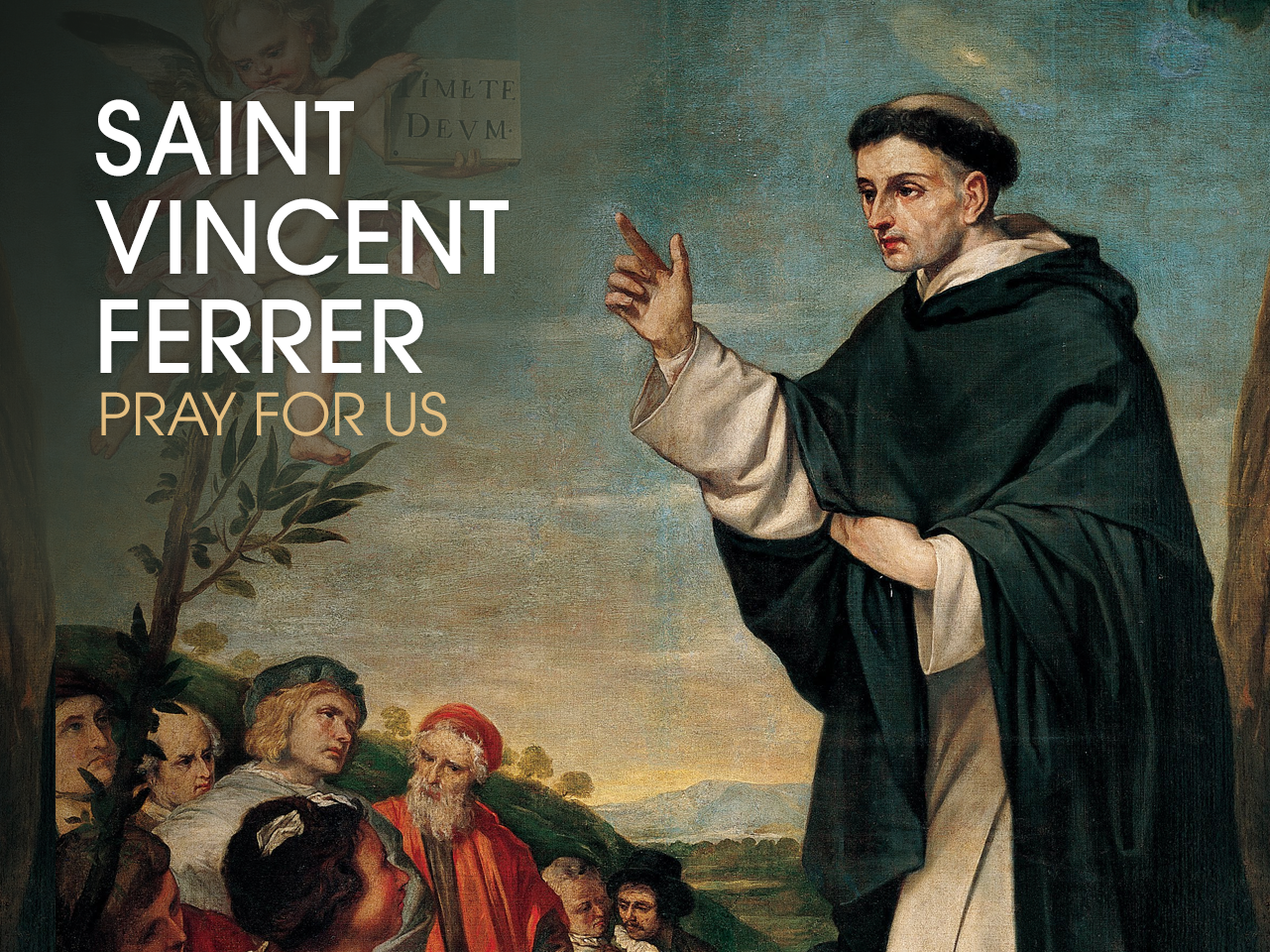
Category Archives: Saints
May 2 – St Athanasius (293-373 AD), Bishop, Father & Doctor of the Church, Defender of the orthodox Faith
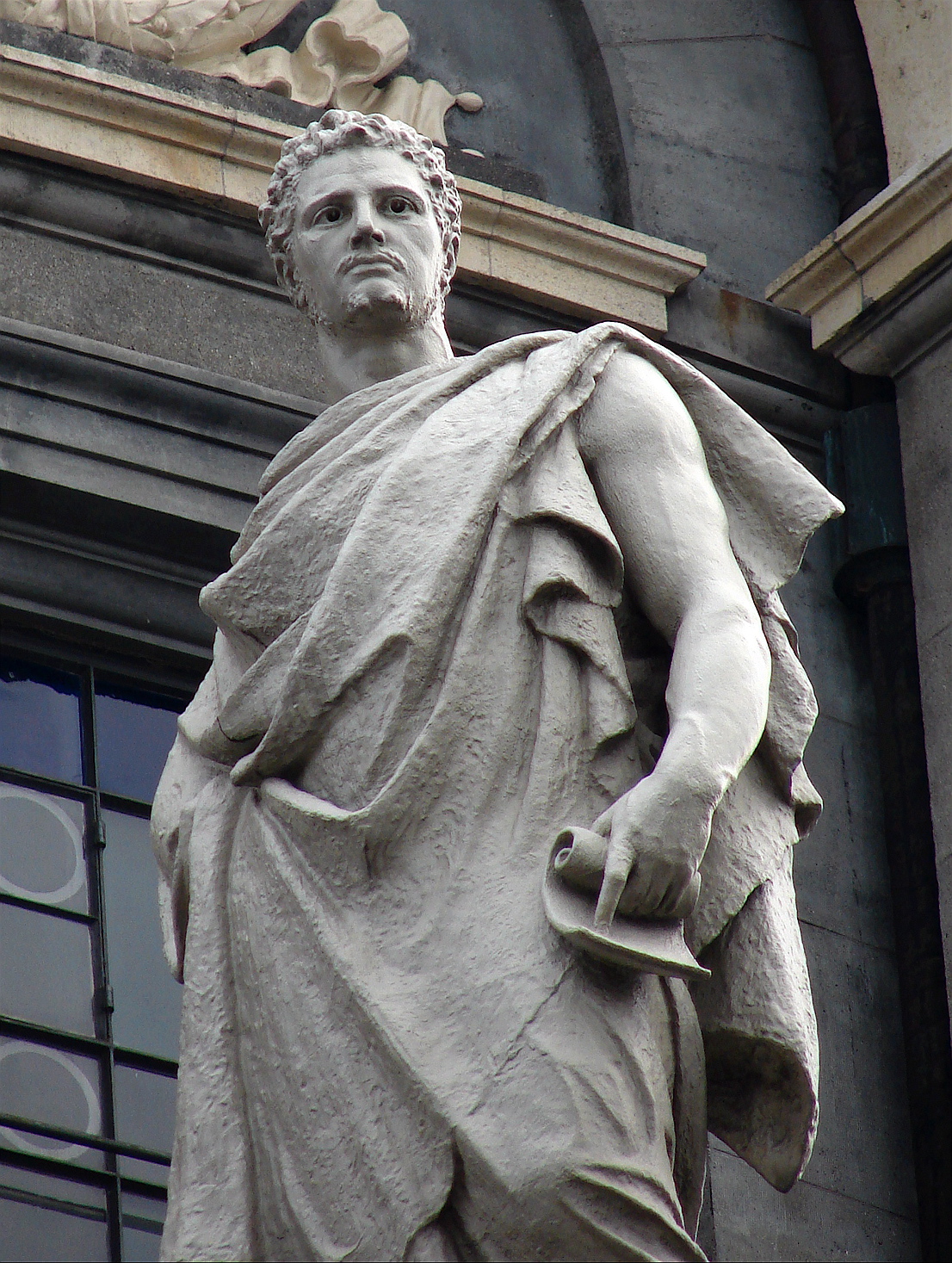
-St. Athanasius (1883–84), by Carl Rohl-Smith, Frederik’s Church, Copenhagen, Denmark.
In my study of and training in Christology, I have come to learn and to observe nearly every varied interpretation and manipulation, if you will, throughout history has been attempted, offered, and promulgated by heretics as to whom Jesus was and is. There is a truth and a saying when one studies Church history: “there are no new heresies”. This is so true. That word, heresy, grates on the modern ear. We much prefer the calm, soothing, comforting, anesthetizing sounds of relativism – contemplation without thought, without challenge. Peace at any cost, peace in our time. Thank you, St Neville Chamberlain (Warning: NOT a real saint!) This is so as opposed to a more challenging, sobering truth.
The rational mind with integrity cannot accept mutually exclusive truths and rest easy. The Church may have to deal with heresies for a time, from time to time, hopefully refute and suppress them successfully, but given the mind of man, general ignorance of and training in the theological sciences, our own willfulness and refusal to learn from our forbears in faith who have climbed Himalayan mountains of faith, thought, and life’s experiences, add in the work of the Enemy, and heresies constantly return over time mutated, altered, changed, but still holding onto the core deception. Bad thinking leads to bad action. History is replete with examples.
The most difficult conclusion human beings have had to come to, the hardest to hold, and the most embattled throughout human history, is that He was Whom He said He was: the Son of the Father, co-equal with the Creator and the Holy Spirit in true Trinitarian theology. I feel this is the most challenging since it begs of us the most difficult questions and challenges us profoundly. How would we live differently if His divinity were not an article of faith? But, rather, a daily, moment-by-moment live experience of fact – as we define fact? How would we live differently if we knew our appointment with Him were not merely a possibility, but an inevitability? For this reason, I believe this conclusion is the most difficult to which to come and hold because of the profound challenges and questions it poses – too much to bear many would claim. Hence, the heresies, both ancient and modern, and the human temptation towards them continue.
Arius (250-336 AD) was a bishop from Alexandria, Egypt. He taught that Jesus did not always exist, but was created by the Father and was of a different substance than the Father, nearly, or actually, implying Jesus was perhaps divine, but not Divine as God is Divine, but also a creature of God, like us, only better. At the heart of the Arian heresy, if taken to its logical conclusion, was truly to call into question Jesus’ divinity. At best, a second rate divinity, really.
It is really helpful at this point if one knows a little Greek and understands how one letter, “i”, one iota, literally, can change the entire meaning of a word and generally cause a big fight. But, I will spare you that for now. (Jehovah’s Witnesses and Seventh Day Adventists have sometimes been referred to as Arians or Semi-Arians. Unitarian Universalists deny the Trinity altogether, as well as several other problems. Gnosticism, which pre-dates Christianity, has been recreated in the modern age as Freemasonry and Scientology.)
Ok, I lied,
homoiousios/ηομο and homoousios/ηομοουσιος The first, the heretical word if inserted into the Creed, means of a “similar essence/substance”. The second means of the “same essence/substance”. BIG FIGHT!!!!! It caused such a huff, the Emperor Constantine ordered a Church council to meet, the Council of Nicea (325 AD), and work it out for the sake of peace in the empire. Wars have been fought over the words in the Creed, which is why I am always so scandalized when new, creative, modern, “Oh, what the hell. Let’s use this one today” type creeds get used rather blithely in Christian, especially Catholic worship. No wonder people, even the ordained, mea culpa, are often confused. When I teach young people, consistently they present their brains to me as so much theological mush. I fancy myself a theological personal trainer for the young – tightening their theological core, as my actual personal physical trainer is teaching me to tighten mine. Ouch! I am a certified catechist, you know. St Athanasius, pray for us!
When we recite the Nicene Creed (325 AD), it is the words,”We believe in one Lord, Jesus Christ, the only Son of God, eternally begotten of the Father, God from God, Light from Light, true God from true God, begotten, not made, one in being with the Father”, think of and thank St Athanasius, and those who held to the orthodox belief of the Trinity despite profound opposition and difficulty. We have Arius to thank that we are so emphatic, repeating over and over this truth when we pray the Creed, seventeen centuries later. Arius had trouble with the Trinity. Granted, that’s a tough one for any Christian, even the most erudite theologians, to wrap their minds around, let alone explain. Hence the ascription as mystery. But, mystery as it may be, most Christians do not slip into heresy and lead others to follow because they don’t like it, most.
St. Athanasius (296-373 A.D.) was born in Alexandria, Egypt, to noble Christian parents. He received an excellent education in theology, philosophy, rhetoric, and law, which he directed to the service of God. He made great progress in both wisdom and virtue, and made a spiritual retreat in the Egyptian desert with St. Anthony the Great. St. Athanasius became the Bishop of Alexandria and served in that role for 46 years. He tirelessly and courageously devoted most of his life to defeating the Arian heresy, which denied the divinity of Christ. When the majority of his fellow bishops were Arian heretics, which threatened the integrity of the whole Church, Athansius stood firmly and almost single-handedly against their error using his philosophical knowledge, theological wisdom, rhetorical skill, and strength of spirit. Despite having the support of several popes, he suffered great trials, scandals, and persecutions at the hands of his doctrinal enemies, and spent much of his life in exile. He was a participant in the Council of Nicea in 325 A.D. and did much of the theological work which supported the condemnation of the Arian heresy and the formulation of the Nicene Creed.
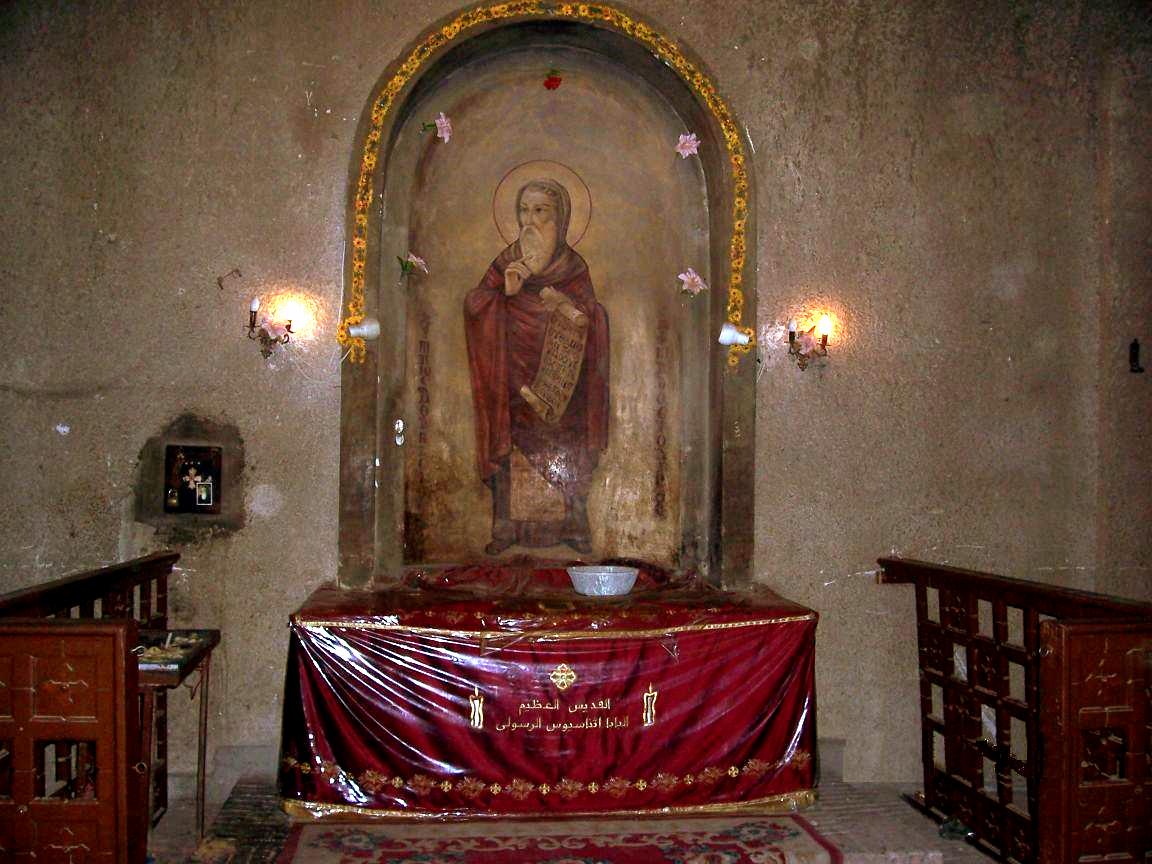
-Athanasius’ Shrine (where a portion of his relics are preserved) under St. Mark’s Cathedral, Cairo
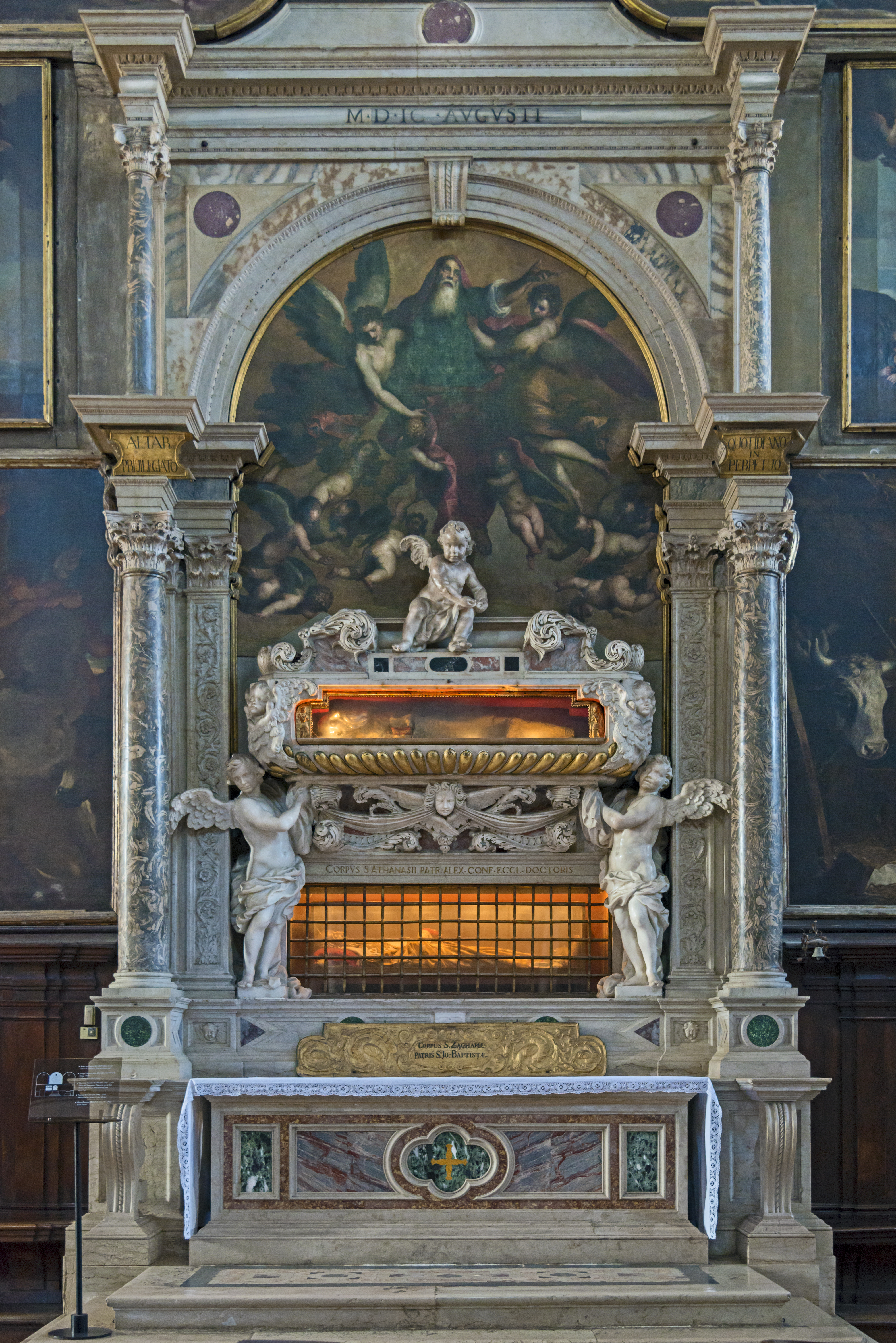
“Even on the cross He did not hide Himself from sight; rather, He made all creation witness to the presence of its Maker. Then, having once let it be seen that it was truly dead, He did not allow that temple of His body to linger long, but forthwith on the third day raised it up, impassible and incorruptible, the pledge and token of His victory.”
— St. Athanasius of Alexandria
“You will not see anyone who is really striving after his advancement who is not given to spiritual reading. And as to him who neglects it, the fact will soon be observed by his progress.”
-St Athanasius
“The floor of Hell is paved with the skulls of bishops” – St. Athanasius, Council of Nicea, 325 AD
“Jesus, Whom I know as my Redeemer, cannot be less than God.”
-St Athanasius of Alexandria
“[Jesus’] body was for Him not a limitation, but an instrument, so that He was both in it and in all things, and outside all things, resting in the Father above. At one and the same time—this is the wonder—as man He was a human life, and as Word He was sustaining the life of the universe, and as Son He was in constant union with the Father.”
–St. Athanasius of Alexandria
“Now, man is afraid of death by nature, afraid of the decay of the body. But here is a really starling fact: whoever has put on the faith of the Cross despises even what is naturally dreadful, and for Christ’s sake is not afraid of death. So if anyone is skeptical even now, after so many proofs, and after so many have become martyrs to Christ, and after those who are champions in Christ have shown scorn for death every day—if his mind is still doubtful about whether death has been brought to nothing and come to an end—well, he’s right to wonder at such a great thing. But he should not be stubborn in his skepticism, or cynical in the face of what is so obvious. Let him who is skeptical about the victory over death receive the faith of Christ, and come over to His teaching. Then he will see how weak death is, and the triumph over it. Many who used to be skeptics and scoffers have later believed, and despised death even enough to become martyrs for Christ Himself.”
—St. Athanasius
“For He became man that we might become divine; and He revealed Himself through a body that we might receive an idea of the invisible Father; and He endured insults from men that we might inherit incorruption.”
–St. Athanasius of Alexandria
“Devils take great delight in fullness, drunkenness, and bodily comfort. Fasting possesses great power and it works glorious things. To fast is to banquet with angels.”
-St. Athanasius
“Christians, instead of arming themselves with swords, extend their hands in prayer.”
-St. Athanasius
“For, indeed, everything about is marvelous, and wherever a man turns his gaze he sees the Godhead of the Word and is smitten with awe.”
-St. Athanasius
“You cannot put straight in others what is warped in yourself.”
— St. Athanasius of Alexandria
Love,
Matthew
May 25 – St Mary Magdalen de Pazzi (1556-1607), Carmelite Mystic & Great Catholic Reformer, “To suffer and not to die”
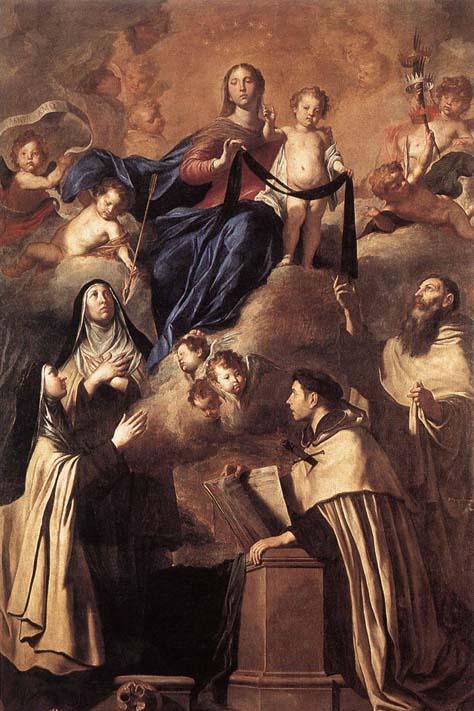
–“Our Lady of Carmel and Saints”, by Pietro Novelli, 1641, Simon Stock (standing), Angelus of Jerusalem (kneeling), Mary Magdalene de Pazzi, Teresa of Avila, Museo Diocesano, Palermo
It would be easy to concentrate on the mystical experiences God gave this saint, rather than on her life. In fact, it would be difficult to do differently, so overwhelming were those gifts from God. The temptation for many modern readers (including the author) would be to see little to identify with in these graces and walk away without seeing more. The other temptation would be to become so fascinated with these stories that one would neglect to dig deeper and learn the real lessons of her life.
But Mary Magdalene de Pazzi is not a saint because she received ecstasies and graces from God. Many have received visions, ecstasies, and miracles without becoming holy. She is a saint because of her response to those gifts — a lifelong struggle to show love and gratitude to the God who gave her those graces.
In fact Mary Magdalene saw her ecstasies as evidence of a great fault in her, not a reward for holiness. She told one fellow sister that God did not give this sister the same graces “because you don’t need them in order to serve him.” In her eyes, God gave these gifts to those who were too weak to become holy otherwise. That Mary Magdalene received these gifts proved, in her mind, how unworthy she was.
Born into one of the wealthiest and most distinguished noble families in Florence on April 2, 1566, the normal course would have been for Catherine de Pazzi to have married wealth and enjoyed comfort. Baptized Catherine, she was taught mental prayer when she was nine years old at the request of her mother. Her introduction at this age to this form of prayer which involves half an hour of meditation did not seem to be unusual. And yet today we often believe children incapable of all but the simplest rote prayers. At twelve years old she experienced her first ecstasy while looking at a sunset which left her trembling and speechless. She received religious training from the Jesuits.
With this foundation in prayer and in mystical experience, it isn’t surprising that she wanted to enter a contemplative monastery of the Carmelite Order. She chose the monastery of St. Mary’s of the Angels because the nuns took daily Communion, unusual at the time.
In 1583 she had her second mystical experience when the other nuns saw her weeping before the crucifix as she said, “O Love, you are neither known nor loved.”
Mary Magdalene’s life is a contradiction of our instinctive thought that joy only comes from avoiding suffering. A month after being refused early religious profession, she fell deathly ill. Fearing for her life the convent had her professed from a stretcher at the altar. After that she experienced forty days of ecstasies that coexisted with her suffering. Joy from the graces God gave were mixed with agony as her illness grew worse. In one of her experiences Jesus took her heart and hid it in his own, telling her he “would not return it until it is wholly pure and filled with pure love.” She didn’t recover from her illness until told to ask for the intercession of Blessed Mary Bagnesi over three months later.
As a safeguard against deception and to preserve the revelations, her confessor asked Mary Magdalene to dictate her experiences to sister secretaries. Over the next six years, five large volumes were filled. The first three books record ecstasies from May of 1584 through Pentecost week the following year. A severe five-year trial would follow. The fourth book records that trial and the fifth is a collection of letters concerning reform and renewal. Another book, “Admonitions”, is a collection of her sayings arising from her experiences in the formation of women religious.
What her experiences and prayer had given her was a familiar, personal relationship with Jesus. Her conversations with Jesus often take on a teasing, bantering tone that shocks those who have a formal, fearful image of God. For example, at the end of her forty days of graces, Jesus offered her a crown of flowers or a crown of thorns. No matter how often she chose the crown of thorns, Jesus kept teasingly pushing the crown of flowers to her. When he accused her, “I called and you didn’t care,” she answered back, “You didn’t call loudly enough” and told him to shout his love.
She learned to regret the insistence on the crown of thorns. We might think it is easy to be holy if God is talking to you every day but few of us could remain on the path with the five year trial that followed her first ecstasies. Before this trial, Jesus told her, “I will take away not the grace but the feeling of grace. Though I will seem to leave you I will be closer to you.” This was easy for her to accept in the midst of ecstasy but, as she said later, she hadn’t experienced it yet. At the age of nineteen she started five years of dryness and desolation in which she was repelled by prayer and tempted by everything. She referred to her heart as a pitch-dark room with only a feeble light shining that only made the darkness deeper. She was so depressed she was found twice close to suicide. All she could do to fight back was to hold onto prayer, penance, and serving others even when it appeared to do no good.
Her lifelong devotion to Pentecost can be easily understood because her trial ended in ecstasy in 1590. At this time she could have asked for any gifts but she wanted two in particular: to look on any neighbor as good and holy without judgment and to always have God’s presence before her. She dedicated herself to the reform and renewal of the Church. Her great desire for Church reform was born during this time, after witnessing rays of light from on high in the summer of 1586, showing her the true state of the Church in the era after the Council of Trent. Like Catherine of Siena, she felt ‘compelled’ to write letters to the Pope, cardinals of the Curia, her archbishop and other Church leaders, encouraging them to work for the renewal of the Church.
Far from enjoying the attention her mystical experiences brought her, she was embarrassed by it. For all her days, she wanted a hidden life and tried everything she could to achieve it. When God commanded her to go barefoot as part of her penance and she could not walk with shoes, she simply cut the soles out of her shoes so no one would see her as different from the other nuns. If she felt an ecstasy coming on, she would hurry to finish her work and go back to her room. She learned to see the notoriety as part of God’s will. When teaching a novice to accept God’s will, she told her, “I wanted a hidden life but, see, God wanted something quite different for me.”
Some still might think it was easy for her to be holy with all the help from God. Yet when she was asked once why she was weeping before the cross, she answered that she had to force herself to do something right that she didn’t want to do. It’s true that when a sister criticized her for acting so different, she thanked her, “May God reward you! You have never spoken truer words!” but she told others it hurt her quite a bit to be nice to someone who insulted her.
Mary Magdalene was no pale, shrinking flower. Her wisdom and love led to her appointment to many important positions at the convent including mistress of novices. She did not hesitate to be blunt in guiding the women under her care when their spiritual life was at stake. When one of the novices asked permission to pretend to be impatient so the other novices would not respect her so much, Mary Magdalene’s answer shook this novice out of this false humility: “What you want to pretend to be, you already are in the eyes of the novices. They don’t respect you nearly as much as you like to think.”
Mary Magdalene’s life offers a great challenge to all those who think that the best penance comes from fasting and physical discomfort. Though she fasted and wore old clothes, she chose the most difficult penance of all by pretending to like the things she didn’t like. Not only is this a penance most of us would shrink from but, by her acting like she enjoyed it, no one knew she was doing this great penance!
In 1604, headaches, paralyzation, and tuberculosis confined her to bed. Her nerves were so sensitive that she could not be touched without agonizing pain. Ever humble, she took the fact that her prayers were not granted as a sure sign that God’s will was being done. For three years she suffered, before dying on May 25, 1607 at the age of forty-one. Even to this day, her body remains with the Carmelite community in which she lived and is incorrupt, and is under the altar of the Church of the Monastery of St. Mary Magdalene de’ Pazzi in Careggi, Florence.

-The Ecstasy of Saint Mary Magdalen de Pazzi” ,1670, by Alessandro Rosi (1627-1707), oil on canvas, 120 x 102 cm. Sold $90,900 (2008, Christie’s), Musée des Beaux-arts, Chambéry, France
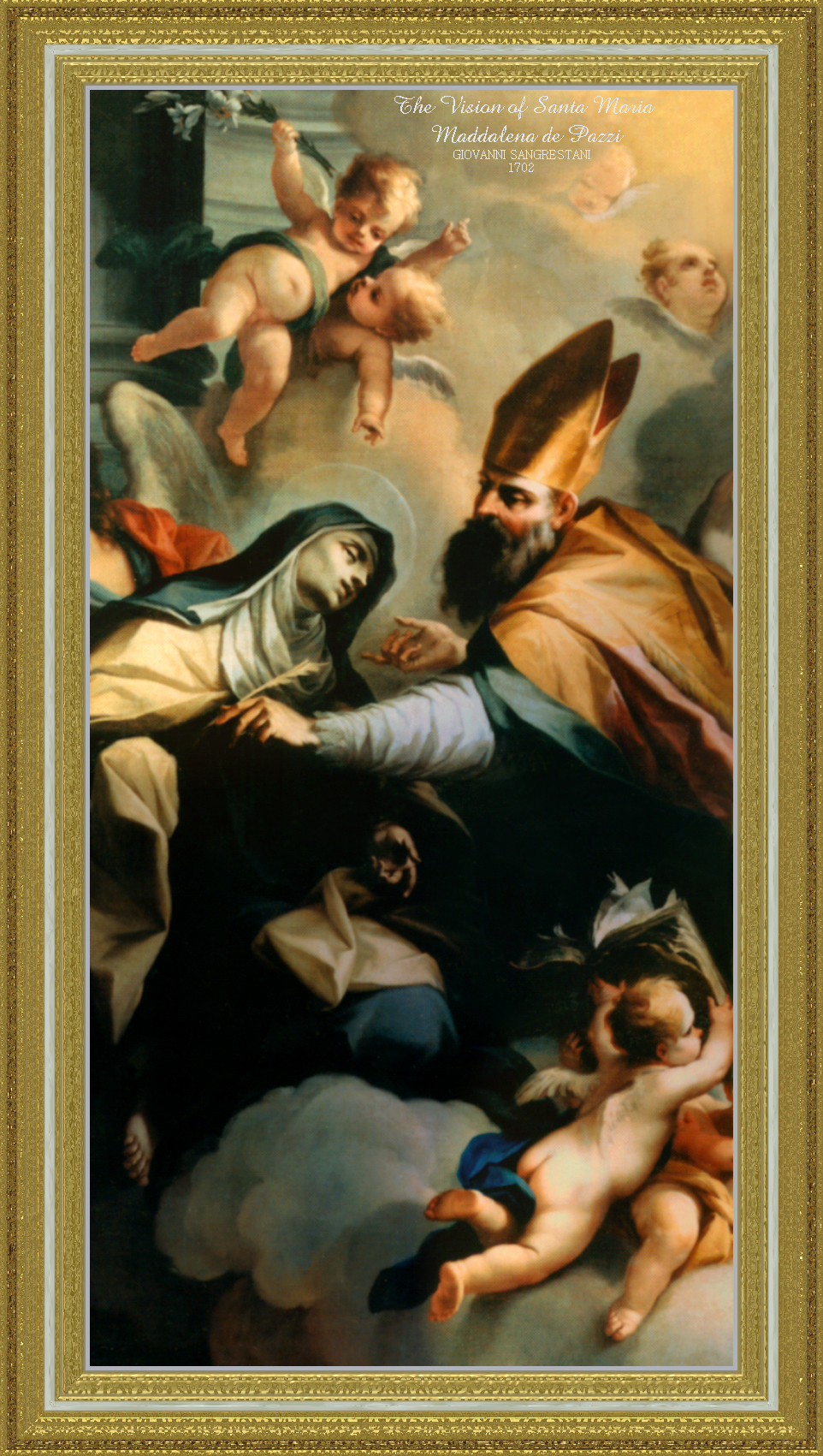
-“The Vision of Santa Maria Maddalena de Pazzi”, 1702, by Giovanni Sangrestani

-Carmelite Saints: Prophet Elijah; Cyril of Constantinople ;Andrew Corsini, Bishop and Peacemaker; Mary Magdalene de’Pazzi; Brocard, the first Superior of Mount Carmel; Thérèse, The Little Flower; Simon Stock; Our Lady of Mount Carmel with Child Jesus; Albert of Sicily; Teresa of Jesus; Berthold, the Second Prior General of the Carmelites; Patriarch Peter Thomas; Angelus of Sicily; John of the Cross; and the Prophet Eliseus.
Prayer ought to be humble, fervent, resigned, persevering, and accompanied with great reverence. One should consider that he stands in the presence of a God, and speaks with a Lord before whom the angels tremble from awe and fear.”
– Saint Mary Magdalen de Pazzi
“Come, Holy Spirit. Spirit of truth, you are the reward of the saints, the comforter of souls, light in the darkness, riches to the poor, treasure to lovers, food for the hungry, comfort to those who are wandering; to sum up, you are the one in whom all treasures are contained.
Come! As you descended upon Mary that the Word might become flesh, work in us through grace as you worked in her through nature and grace.
Come! Food of every chaste thought, fountain of all mercy, sum of all purity.
Come! Consume in us whatever prevents us from being consumed in You.”
– from the writings of Saint Mary Magdalene de Pazzi
“A little drop of simple obedience is worth a million times more than a whole vase of the choicest contemplation.”
– Saint Mary Magdalen de’ Pazzi
“If I thought that by saying a word, however indifferent, for any other end than the love of God, I could become a Seraph, I certainly would not say it.” – Saint Mary Magdalen de’ Pazzi
“If I had a voice sufficiently loud and strong to be heard in every part of the world, I would cry out to make this Love known, loved, and honored by all men as the one immeasurable Good.” -St. Mary Magdalene de Pazzi
“Trials are nothing else but the forge that purifies the soul of all its imperfections.”
-St Mary Magdalen de’ Pazzi
“You will be consoled according to the greatness of your sorrow and affliction; the greater the suffering, the greater will be the reward.” –St. Mary Magdalene de Pazzi
Prayer:
Saint Mary Magdalene de Pazzi, pray that we will make a commitment to seek the presence of God in prayer the way you did. Guide us to see the graces God gives us as gifts not rewards and to respond with gratitude and humility, not pride and selfishness. Amen
“St. Mary Magdalene de’ Pazzi is a symbolic figure of living love that recalls an essential dimension of every Christian life,” said Benedict XVI in 2007. The Pope said this in a letter to the Cardinal Ennio Antonelli of Florence, Italy, in honor of the 400th anniversary of the Carmelite mystic’s death.”She did not let herself be conditioned by the world; the world, though Christian, did not satisfy her desire to become ever more similar to her crucified Spouse,” wrote the Holy Father. “Purified love, which beat so strongly in her heart, opened her to the desire for full conformity with Christ, her Spouse, even unto sharing with him the ‘nudo patire’ [naked suffering] of the cross,” the Pope continued. “The last three years of her life were a true Calvary of sufferings for her.” Benedict XVI added: “During her life she would ring the bells and exhort her fellow sisters saying: ‘Come to love Love!’ The great mystic from Florence, from her convent and from the Carmelite monasteries that aspire to her, we pray that we may still hear her voice in the entire Church, spreading the proclamation of God’s love for every human creature.”
“In order to understand the greatness of Your divinity, O Lord, I need faith; and in order to accomplish anything, I need hope, for if I did not have hope of possessing You some day, I would not have the strength to labor here below. I no longer desire the things of earth, although I have never hoped in them. I do have a lively hope of obtaining, not the things of earth upon which worldly people usually set their hopes, but only You, my God.
O God, give me a firm hope, for I cannot be saved unless this virtue is firmly rooted in my soul. I need it in order to implore pardon for my sins and to attain my end. What delight hope gives to my soul, making it hope for what it will one day enjoy in heaven, and by permitting it a partial taste here on earth of what it will savor, understand, and possess eternally, which is You, my God” (-St. Mary Magdalen dei Pazzi).
“Lord, already I have suffered and not died, by your grace. Give me always this grace to suffer, to learn how to suffer, to offer up unavoidable suffering as a sweet, fragrant, and perfect, most perfect, oblation to You, most acceptable to You. I do this in faith of You and Your Providence; that whatever Your will for me, is ultimately for my greatest good, and is Your holy will. God give me strength to do your will.” -MPM
Love,
Matthew
May 25 – St Bede the Venerable, (673-735 AD), Doctor of the Church, Father of English History
He was known as the most learned man of his day, and his writings started the idea of dating this era from the incarnation of Christ. The central theme of Bede’s “Historia ecclesiastica gentis Anglorum (The Ecclesiastical History of the English People)” is of the Church using the power of its spiritual, doctrinal, and cultural unity to stamp out violence and barbarism. Our knowledge of England before the 8th century is mainly the result of Bede’s writing.
It was as a teacher that Bede was supreme. He had no interest in speculation and no desire to be original; his genius was that of one who, with infinite pains, educates himself and transmits not only what he has learned but a deep sense of the value of such knowledge. Of his oral teaching–to which he attached great importance–of course we cannot speak, but his books became standard works of reference in his own lifetime.
His carefulness and sobriety of approach, his pains to be accurate, his obvious orthodoxy, gave to them a unique authority. Bede’s works fall into three well-defined classes. His theological writings consist mainly of a teacher’s commentaries on the Bible, based very largely on the western Fathers and written for the most part in the allegorical manner of Christian tradition. Bede used his knowledge of Greek and displayed what we may think was an innocent vanity in making the most of such Hebrew as he had learned. Yet, despite the lack of originality in his approach, the commentaries of Bede remain even today one of the best means to arrive at the thought of the early Fathers.
His scientific writings consist partly of traditional explanations of natural phenomena, in which the poetic approach of St. Ambrose is sometimes reflected, and partly of treatises on the calendar and the calculation of Easter–a matter of moment, as the Paschal controversy between Saxons and Celts had by no means entirely died down. It was Bede’s popularization of the method of calculating calendar years from the supposed date of our Lord’s birth which more than anything else ensured its universal acceptance in western Christendom.
At the time Bede wrote the Historia Ecclesiastica, there were two common ways of referring to dates. One was to use indictions, which were 15-year cycles, counting from 312 AD. There were three different varieties of indiction, each starting on a different day of the year. The other approach was to use regnal years—the reigning Roman emperor, for example, or the ruler of whichever kingdom was under discussion. This meant that in discussing conflicts between kingdoms, the date would have to be given in the regnal years of all the kings involved. Bede used both these approaches on occasion, but adopted a third method as his main approach to dating: the anno domini method invented by Dionysius Exiguus. Although Bede did not invent this method, his adoption of it, and his promulgation of it in De Temporum Ratione, his work on chronology, is the main reason why it is now so widely used.
His death was as sober and undeterred as was his life. In the early summer of 735, when he was sixty-three, his health began to fail, and he suffered much from asthma. He was, however, at work until the very end. On the Tuesday before Ascension Day he summoned the priests of the monastery, made them little gifts of pepper and incense and begged their prayers. At intervals during the next forty-eight hours, propped up in bed, he dictated to the very last sentence an English rendering of the Gospel of St. John upon which he was engaged at the onset of his illness. Finally, asking to be laid on the floor, he sang the anthem ‘O King of Glory’ from the Office of Ascension Day and so died. It was May 27th, 735.
“Unfurl the sails, and let God steer us where He will.”
-St. Bede the Venerable
Prayer to St Bede:
“Careful Historian and Doctor of the Church, lover of God and of truth, you are a natural model for all readers of God’s inspired Word. Move lectors to prepare for public reading by prayerfully pondering the sacred texts and invoking the Holy Spirit. Help them to read in such a way that those who hear may attain learning and edification. Amen.”
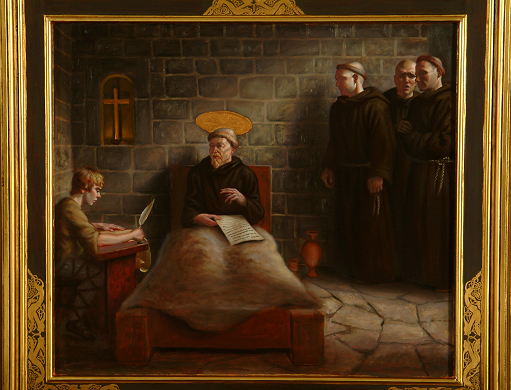
-“St Bede Dictates the Translation of the Gospel of John on his deathbed”, one of four scenes on triptych by David Hewson, 2003, St Bede Catholic Church, Williamsburg, VA
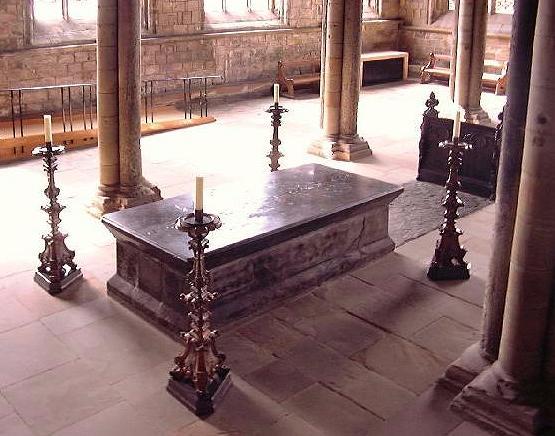
-St Bede’s tomb, Durham Cathedral

Love,
Matthew
May 12 – Sts Nereus, Achilleus, & Domitilla, (d. 98 AD), Martyrs
Christian devotion to Nereus & Achilleus goes back to the earliest years of the Church, though almost nothing is known of their lives. They were praetorian soldiers of the Roman army, possibly ordered to persecute Christians, they became Christians and were banished to the island of Terracina, where they were martyred by beheading in 98 AD by order of the Emperor Domitian. Beheading was befitting Roman citizens, similar to St Paul, as opposed to crucifixion – a much longer suffering death reserved for non-Roman citizens. The bodies of Nereus & Achilleus were buried in a family vault, later known as the cemetery of Domitilla. Excavations by De Rossi in 1896 resulted in the discovery of their empty tomb in the underground church built by Pope Siricius in 390 AD.
Everyday, especially twenty-first century, Christians would first be introduced to Nereus by reading St Paul’s Letter to the Romans 16:15, “Greet Philologus, Julia, Nereus and his sister, and Olympas, and all the holy ones who are with them…”. It is believed Nereus, Achilleus, and Domitilla, along with other early Christians in Rome were all baptized by St Peter before his crucifixion in ~64 AD.
Domitilla was a Roman noble woman. Grand-daughter of Emperor Vespasian; niece of Emperors Titus and Domitian. Married to Titus Flavius Clemens, a Roman consul, nephew of Emperor Vespasian, and first cousin of Emperors Titus and Domitian. Banished to the island of Pandataria in the Tyrrhenian Sea, her husband was martyred in 96 AD.
For Nereus, Achilleus, and Domitilla, they were all martyred together. Their empty tombs were located and identified in the catacomb of Domitilla, part of her former estate near the Via Ardeatina.

-by Andrea_di_Bonaiuto, “St._Agnes_and_St._Domitilla”,_1365, Galleria dell’Accademia, Florence, Italy.
Two hundred years after their death, Pope Gregory the Great delivered his 28th homily on the occasion of their feast. “These saints, before whom we are assembled, despised the world and trampled it under their feet when peace, riches and health gave it charms.”
Pope Damasus wrote an epitaph for Nereus and Achilleus in the fourth century. The text is known from travelers who read it while the slab was still entire, but the broken fragments found by De Rossi are sufficient to identify it: “The martyrs Nereus and Achilleus had enrolled themselves in the army and exercised the cruel office of carrying out the orders of the tyrant, being ever ready, through the constraint of fear, to obey his will. O miracle of faith! Suddenly they cease from their fury, they become converted, they fly from the camp of their wicked leader; they throw away their shields, their armor and their blood-stained javelins. Confessing the faith of Christ, they rejoice to bear testimony to its triumph. Learn now from the words of Damasus what great things the glory of Christ can accomplish.”

-(please click on the image for greater detail), Basilica Catacombs of St Domitilla, part of her former estate, on the outskirts of Rome, the Eternal City.
The church marks the spot where tradition says Sts Nereus & Achilleus were executed for converting to Christianity. And beneath the altar, and extending through more than 10 miles of tunnels, were the tombs of more than 100,000 Christians from the earliest centuries of the church.


-(please click on the image for greater detail) Santi Nereo e Achilleo is an ancient church dedicated to St Nereus and St Achilleus, 4th century soldier martyrs.
The present church is the result of a restoration by Cesare Cardinal Baronio – historian and titular priest of the church – in 1596-1597/8. The work was done carefully in order to preserve as much as possible of the ancient church and to restore ancient elements that had been lost. Some of the decorations that were added were taken from San Paolo fuori le mura. Sts Nereus and Achilleus are buried beneath the high altar, together with St Flavia Domitilla. Their remains were brought here from the Catacombi di Domitilla, where they had been placed in the underground basilica. The floor in the choir was raised by Baronio in the late 16th century, to create a proper confessio beneath the high altar. The baldachino is from the 16th century, and has columns of African marble.
Cardinal Baronio asked Pope Clement VIII (1592-1605) to entrust the church to his order, the Oratorians. They still serve the church.
Love,
Matthew
Apr 23 – Saint George, (d. 304 AD), Martyr

-please click on the image for greater detail
In Christian hagiography, Saint George – The Saint who killed the Dragon (ca. 275-281?-April 23, 303) was a soldier of the Roman Empire, from Anatolia, now modern day Turkey, who is venerated as a Christian martyr.
George was born to a Christian family during the late 3rd century. His father, Geronzio, was from Cappadocia and served as an officer of the Roman army, but was killed in battle. His mother, Policronia, was from Lydda, Iudaea (now Lod, Israel). She returned to her native city as a widow along with her young son, where she provided him with an education.
The youth followed his father’s example by joining the army soon after coming of age. He proved to be a good soldier and consequently rose through the military ranks of the time. By his late twenties he had gained the title of Tribunus (Tribune) and then Comes (Count), at which time George was stationed in Nicomedia as a member of the personal guard attached to Roman Emperor Diocletian, who embraced him, having known and regarded his father as one of his finest soldiers.
In 303 Diocletian, influenced by Galerius, issued an edict authorizing the systematic persecution of Christians across the Empire. The emperor Galerius would continue the persecution during his own reign (305-311).
George was ordered to take part in the persecution but instead confessed to being a Christian himself and criticized the imperial decision. Diocletian was upset, not wanting to lose his best Tribune and the son of his former best official. George loudly denounced the Emperor’s edict, and in front of his fellow soldiers and Tribunes he claimed himself to be a Christian and declared his worship of Jesus Christ. Diocletian attempted to convert George, even offering gifts of land, money and slaves if he made a sacrifice to the pagan gods. The Emperor made many offers, but George never accepted. An enraged Diocletian ordered the torture of this apparent traitor, and his execution.
Before the execution George gave his wealth to the poor and prepared himself.
After various tortures, beginning with being lacerated on a wheel of swords in which he was revived three times, George was executed by decapitation before Nicomedia’s defensive wall on April 23, 303. The witness of his suffering convinced Empress Alexandra and Athanasius, a pagan priest, to become Christians as well, and so they joined George in martyrdom. His body was returned to Lydda for burial, where Christians soon came to honor him as a martyr.
Saint George is one of the most venerated saints in the Eastern Orthodox Church and Oriental Orthodox Churches. Immortalized in the tale of George and the dragon, he is the patron saint of Canada, Catalonia, England, Ethiopia, Georgia, Greece, Montenegro, Portugal, Serbia, the cities of Beirut, Istanbul, Ljubljana and Moscow, as well as a wide range of professions, organizations and disease sufferers.
In the legend of St George and the dragon, brought back to Europe by Crusaders, a dragon makes its nest at the spring that provides water for the city of Cyrene in Libya or the city of Lydda, depending on the source you consult. Consequently, the citizens have to dislodge the dragon from its nest for a time, in order to collect water. To do so, each day they offer the dragon a human sacrifice. The victim is chosen by drawing lots.
One day, this happened to be the princess. The monarch begs for her life with no result. She is offered to the dragon, but there appears the saint on his travels. He faces the dragon, slays it and rescues the princess. The grateful citizens abandon their ancestral paganism and convert to Christianity.
In Sweden, the princess rescued by Saint George is held to represent the kingdom of Sweden, while the dragon represents an invading army. Several sculptures of Saint George battling the dragon can be found in Stockholm, the earliest inside Storkyrkan (“The Great Church”) in the Old Town.
Prayer in honor of St George
O God, You granted Saint George strength and constancy in the various torments which he sustained for Holy Faith; we beseech You to preserve, through his intercession, our faith from wavering and doubt, so that we may serve You with a sincere heart faithfully unto death. Through Christ our Lord. Amen.
Invocation of St George
Faithful servant of God and invincible martyr, Saint George; favored by God with the gift of faith, and inflamed with an ardent love of Christ, you fight valiantly against the dragons of pride, falsehood, and deceit. Neither pain nor torture, sword nor death could part you from the love of Christ.
I fervently implore you, for the sake of this love, to help me by your intercession to overcome the temptations that surround me, and to bear bravely the trials that oppress me, so that I may patiently carry the cross which is placed upon me; and let neither distress nor difficulties separate me from the love of Our Lord Jesus Christ.
O, Valiant Champion of Faith, assist me in the combat against evil, that I may win the crown promised to them that persevere unto the end.
Amen.
“Saint George was a man who abandoned one army for another: he gave up the rank of tribune to enlist as a soldier for Christ. Eager to encounter the enemy, he first stripped away his worldly wealth by giving all he had to he poor. Then, free and unencumbered, bearing the shield of faith, he plunged into the thick of the battle, an ardent soldier for Christ.
Clearly what he did serves to teach us a valuable lesson: if we are afraid to strip ourselves of our worldly possessions, then we are unfit to make a strong defense of the faith.
Dear brothers & sisters, let us not only admire the courage of this fighter in heaven’s army, but follow his example. Let us be inspired to strive for the reward of heavenly glory. We must now cleanse ourselves, as Saint Paul tells us, from all defilement of body and spirit, so that one day we too may deserve to enter that temple of blessedness to which we now aspire. “
– from a sermon by Saint Peter Damian (1007-1072), priest & one of the Great Catholic Reformers

-tomb of St George, Lod, Israel

-please click on the image for greater detail
Love,
Matthew
Apr 28 – St Peter Chanel, SM, (1803-1841), Apostle to & Protomartyr of Oceania
Anyone who has worked in loneliness, with great adaptation required, and with little apparent success, will find a kindred spirit in Peter Chanel.
Pierre Louis Marie Chanel was born on July 12, 1803 in La Potière near Cuet in the area of Belley, France.
He was ordained priest along with 24 others on 15 July 1827. From an early age Chanel had been thinking about going on the foreign missions and his intention was strengthened by the letters that arrived from a missionary in India.
The following year Chanel applied for permission to go to the missions. His application was not accepted and instead he was appointed for the next three years as parish priest of the run down parish of Crozet. This parish was in dire straits and situated in a seamy district. By the simple method of showing great devotion to the sick, Peter revitalized and reinvigorated the faith of the community surrounding the parish.
Seeming to take one step closer to his ambition of becoming a missionary, in 1831, Peter joined the newly forming Society of Mary (Marists). Instead of being selected as a missionary, however, the Marists used his talents as the spiritual director at the Seminary of Belley, where he patiently and obediently worked for five years.
Finally, he was given permission to be a missionary and traveled to Western Oceania. The bishop accompanying the missionaries left Peter and another Marist brother on Futuna Island in the New Hebrides, promising to return in six months. The interval lasted five years.
The group was initially well received by the island’s king, Niuliki, who had only recently forbidden cannibalism. Meanwhile Peter struggled with this new language and mastered it, making the difficult adjustment to life with whalers, traders and warring natives. Despite little apparent success and severe want, Peter maintained a serene and gentle spirit and endless patience and courage. A few natives had been baptized, a few more were being instructed.
Once the missionaries learned the local language and began preaching directly to the people, the king grew restive. He believed that Christianity would take away his prerogatives as high priest and king. When the king’s son, Meitala, sought to be baptized, the king sent a favored warrior, his son-in-law, Musumusu to “do whatever was necessary” to resolve the problem.
Musumusu initially went to Meitala and the two fought. Musumusu, injured in the fracas went to Chanel feigning need of medical attention. While Chanel tended him a group of others ransacked his house. Musumusu took an axe and clubbed Chanel on the head. His body was cut to pieces by the natives.
Over a year later, for it took that long for news to travel of Peter’s murder and arrangements to be made, a chief named Maligi, who had not agreed to Chanel’s murder, agreed to disinter Fr. Chanel’s body, and brought it to the L’Allier, a French naval corvette, sent to retrieve Peter’s body, wrapped in several local mats. Eventually, with proper and improved care taken of the remains, entrusted from trustworthy hand to trustworthy hand, Peter’s remains were returned to the motherhouse of the Society of Mary in Lyon, France, June 1, 1850.
Within two years after Peter’s death, some sources say five months, the whole island of Futuna became Catholic and has remained so. Musumusu himself converted, and as he lay dying, expressed the desire that he be buried outside the church at Poi so that those who came to revere Peter Chanel in the Church would walk over his grave to get to it. As a kind of penitence a special action song and dance, known as the “eke”, was created by the people of Futuna shortly after Chanel’s death. The dance is still performed in Tonga. Peter Chanel’s remains were returned to Futuna in 1977.
Prayer
St Peter Chanel, you left your homeland to proclaim Jesus, Savior of the world, to the peoples of Oceania. Guided by the spirit of God, who is the strength of the gentle, you bore witness to love, even laying down your life. Grant that like you, we may live our daily life in peace, joy, and in love. May your prayer and example call forth from our midst many workers for the Gospel so that God’s kingdom may reach to the ends of the earth. Amen.
“He loves us. He does what he teaches. He forgives his enemies. His teaching is good.”
– one of Saint Peter’s catechumens, explaining why he believed Peter’s teachings
“It does not matter whether or not I am killed; the religion has taken root on the island; it will not be destroyed by my death, since it comes not from men but from God.”
-St. Peter Chanel
Love,
Matthew
Apr 29 – St Catherine of Siena, O.P., (1347-1380), Doctor of the Church & Unity, Great Catholic Reformer & Mystic
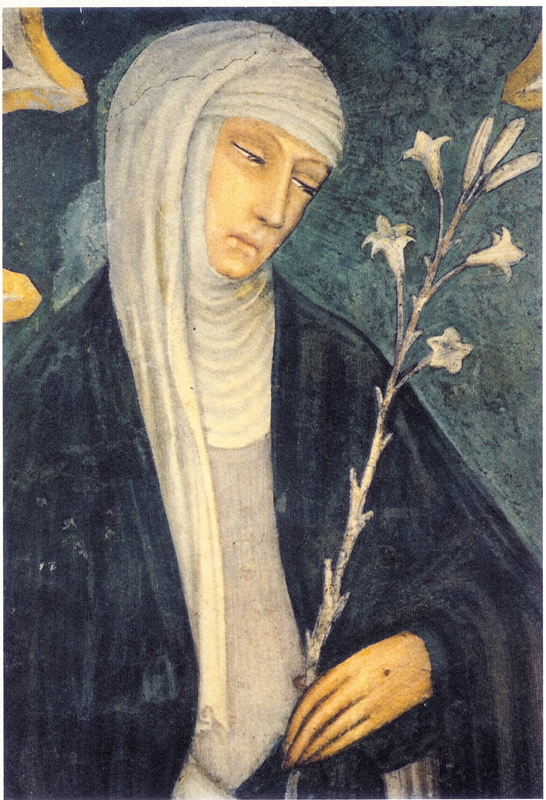
-fresco of St. Catherine of Siena – done by a family member who knew her, showing her true likeness
In her letter #16, to an unidentified “great prelate” (perhaps Cardinal Pietro of Ostia), also this letter doesn’t seem to be on the Internet in English. The original is in medieval Italian, which is not the same as modern Italian, which is why it is not easy to find. The relevant passage is as follows:
“Oimè, non più tacere! Gridate con cento migliaia di lingue. Veggo che, per tacere, il mondo è guasto, la Sposa di Cristo è impallidita, toltogli è il colore, perchè gli è succhiato il sangue da dosso, cìoè che il sangue di Cristo, che è dato per grazia e non per debito.”
Fr. Jerabek renders that as:
“Be silent no more! Cry out with one hundred thousand tongues. I see that, because of this silence, the world is in ruins, the Spouse of Christ has grown pale; the color is taken from her face because her blood has been sucked out, that is the blood of Christ, which is given as a free gift and not by right.”
St Catherine of Siena, OP, one of the Great Reformers of the Catholic Church, publicly excoriated priests, bishops, cardinals, and popes. She called them “wretches”, “idiots”, “blind hirelings”, and “devils incarnate”. Catherine sought to shame the clergy into reform; her methods and her inspiration for reform were direct and challenging.
Catherine claimed that her reform rhetoric was revealed to her in a series of visions. The legitimacy of these visions was reinforced by Catherine’s miracles. From early in her career, she was known for her miraculous ability to subsist solely on the Eucharist, and was given the grace of the stigmata, the wounds of Christ, during her life, among other supernatural phenomena.
Born Catherine Benin in Siena, Italy, to Giacomo di Benincasa, a clothdyer, and Lapa Piagenti, possibly daughter of a local poet, in 1347, she was the last of 25 children. A year after she was born, the Black Death, or bubonic plague, came to Siena for the first time. Sometime around 1353, at the age of seven or eight, Catherine experienced a vision of Christ that led her to make a vow of virginity.
In about 1366, Catherine experienced what she described in her letters as a “Mystical Marriage” with Jesus. Her biographer also records that she was told by Christ to leave her withdrawn life and enter the public life of the world. Catherine dedicated much of her life to helping the ill and the poor, where she took care of them in hospitals or homes.
Her early pious activities in Siena attracted a group of followers, both women and men, while they also brought her to the attention of the Dominican Order, who had primary responsibility for the Inquisition in many regions. Catherine was summoned by the Inquisition to Florence in 1374 to interrogate her for possible heresy. After this visit, in which she was deemed sufficiently orthodox, she began travelling with her followers throughout northern and central Italy advocating reform of the clergy and the launch of a new crusade and advising people that repentance and renewal could be done through “the total love for God.”
Just as Catherine was not repulsed by the filth of her neighbors’ diseased bodies, she was also not repulsed by the corruption manifested in the body of Christ. For most of her career, she tended to the sick, the hungry, and the dying, much like Blessed Teresa of Calcutta has done in our own day. She wrote many letters to religious leaders and secular officials of her day encouraging and demanding, under penalty of perdition, reform, peace, order, atonement, repentance, reconciliation, and adherence to the Gospel.
Her other work, “The Dialogue of Divine Providence”, is one of the most well known works in Catholic mystical writing, referred to simply as St Catherine’s “Dialogue”, or “The Dialogue”. Its premise is a dialogue between a soul who “rises up” to God and God, and was recorded by her followers between 1377 and 1378. She opens with a description of sin and the need for penance. She synthesizes both the apologetics of love and of humility under the rubric of the atonement for sin.
Saint Catherine of Siena in her Dialogue writes about tears. She describes the different ways that God uses our sadness to bring us into ever closer union with Him. We are sad when we encounter the emptiness of sin and the fear of eternal punishment. These turn us away from sin and toward virtue. Those who begin to turn away from sin, however, still lose the things they love, from worldly goods to beloved friends. Those who have grown accustomed to feeling close to God may even feel, for a time, a loss of spiritual consolation, as if God were withdrawing from them. These losses also lead to sadness, although of a very different quality and for different reasons. This helps to purify love of its selfishness, so that the soul may turn more and more to God. Even sadness due to evils committed against God and the people that we love can bring us closer to God, because we can unite our suffering with the suffering of Jesus on the cross. God uses our sadness to lead us to Him.
St Catherine died of an apparent stroke in Rome, in the spring of 1380, at the age of thirty-three. She was proclaimed a Doctor of the Church in 1970, one of only three women and thirty men to hold this title in the history of Christianity.

-St Catherine of Siena Exchanging Her Heart with Christ” by Giovanni di Paolo (Giovanni di Paolo di Grazia) (1398-1492), please click on the image for greater detail, overall, with added strips, 11 3/4 x 9 1/2 in. (29.8 x 24.1 cm); painted surface 11 3/8 x 8 7/8 in. (28.9 x 22.5 cm)
“Saint Catherine of Siena would fervently pray the words of the Psalmist, “Create in me a clean heart, O God, and put a new and right spirit within me” (Ps 51:10).
God responded to St. Catherine’s prayer through two visions of supernatural surgery, which she recounted to her spiritual director and the author of her Life, Blessed Raymond of Capua. In St. Catherine’s first vision, the Lord came to her and she watched him open her left side, remove her heart, and then depart. So vivid and powerful was this vision—which left her with a scar on her side—that Catherine insisted to others that she no longer had a heart!
Soon thereafter, as she was preparing to leave the Dominican church in Siena, Catherine was surrounded by a dazzling light. In this second vision, the Lord held in his hands a fleshy beating heart, gleaming red and aflame with light. Christ approached, opened her side once more, and nestled this new heart into her breast, saying, “See, dearest daughter, a few days ago, I took your heart from you; now, in the same way, I give you my own heart.” Through this gift of grace, St. Catherine had new and eternal life within her. She became so conformed to Christ that all his loves became hers, his will became hers, his heart became hers . . . such that, really and truly, Christ himself lived and loved in her.
In the tradition, this episode of Catherine’s life has been called the “exchange of hearts” with Jesus. Now that is the kind of heart transplant I’m looking for! My heart is failing unto death; sin is my fatal disease. But thanks be to God: in Jesus, I have found someone willing to give me a new heart—to save my life. The Divine Physician says to me and to you: “I will give you a new heart, and put a new spirit within you: and I will take away the stony heart out of your flesh, and will give you a heart of flesh” (Ezek 36:26).
Like other heart donors, Christ has died to offer life to someone else. However, unlike any other organ donor, Christ was raised from the dead and is alive still, reigning at the right hand of the Father in glory. Our heavenly heart donor is not only a man, but also truly God. The heart Jesus gives is not mere corruptible flesh, which only prolongs life for a few years, but the incorruptible heart of God Incarnate: the Sacred Heart, the furnace of Divine Love, the fount of Divine Mercy that bestows life without end.”
“Charity is the sweet and holy bond which links the soul with its Creator: it binds God with man and man with God.” – Saint Catherine of Siena
“The devil fears hearts on fire with love of God.”
-St. Catherine of Siena
“Lord, take me from myself and give me to Yourself.” -St. Catherine of Siena
“Nothing great is ever achieved without much enduring.”
–St. Catherine of Siena
“Oh, how sweet and pleasant to that soul and to Me is holy prayer, made in the house of knowledge of self and of Me, opening the eye of the intellect to the light of faith, and the affections to the abundance of My charity, which was made visible to you, through My visible Only-begotten Son, who showed it to you with His blood! Which blood inebriates the soul and clothes her with the fire of divine charity, giving her the food of the Sacrament . . . that is to say, the food of the Body and Blood of My Son, wholly God and wholly man, administered to you by the hand of My vicar, who holds the key of the Blood.”
—St. Catherine of Siena, Dialogue
“The soul, who is lifted by a very great and yearning desire for the honor of God and the salvation of souls, begins by exercising herself, for a certain space of time, in the ordinary virtues, remaining in the cell of self-knowledge, in order to know better the goodness of God towards her. This she does because knowledge must precede love, and only when she has attained love, can she strive to follow and to clothe herself with the truth. But, in no way, does the creature receive such a taste of the truth, or so brilliant a light therefrom, as by means of humble and continuous prayer, founded on knowledge of herself and of God; because prayer, exercising her in the above way, unites with God the soul that follows the footprints of Christ Crucified, and thus, by desire and affection, and union of love, makes her another Himself.”
—St. Catherine of Siena
“O Deity eternal, O high, eternal Deity, O sovereign, eternal Father, O ever-burning fire!… What do Your bounty and Your grandeur show? The gift You have given to man. And what gift have You given? Your whole self, O eternal Trinity. And where did You give Yourself? In the stable of our humanity which had become a shelter for animals, that is, mortal sins” -St. Catherine of Siena.
“Oh, inestimable Charity, sweet above all sweetness!… It seems, oh, Abyss of Charity, as if thou wert mad with love of Thy creature, as if Thou couldest not live without him, and yet Thou art our God who has no need of us.” – St Catherine of Siena
“You are asking for something that would be harmful to your salvation if you had it—so by not getting what you’ve asked, you really are getting what you want.”
–St. Catherine of Siena
“We are such value to God that He came to live among us … and to guide us home. He will go to any length to seek us, even to being lifted high upon the cross to draw us back to Himself. We can only respond by loving God for His love.
—St. Catherine of Siena
“You are rewarded not according to your work or your time but according to the measure of your love.”
–St. Catherine of Siena
“Consider God’s charity. Where else have we ever seen someone who has been offended voluntarily paying out His life for those who have offended Him?”
—St. Catherine of Siena
Eternal God, eternal Trinity,
You have made the Blood of Christ so precious
through His sharing in Your Divine nature.
You are a mystery as deep as the sea;
the more I search, the more I find,
and the more I find the more I search for You.
But I can never be satisfied;
what I receive will ever leave me desiring more.
When You fill my soul I have an ever-greater hunger,
and I grow more famished for Your light.
I desire above all to see You,
the true light, as you really are.
Amen.
~ St. Catherine of Siena
“Eternal Trinity, Godhead, mystery deep as the sea, You could give me no greater gift than the gift of Yourself. For You are a fire ever burning and never consumed, which itself consumes all the selfish love that fills my being. Yes, you are a fire that takes away the coldness, illuminates the mind with its light, and causes me to know Your truth. And I know that You are beauty and wisdom itself. The food of angels, You gave yourself to man in the fire of your love.” -from “The Dialogue”
“I’ve appointed the Devil to tempt and to trouble My creatures in this life [St. Catherine of Siena reports that Our Lord said to her]. I’ve done this, not so that My creatures will be overcome, but so that they may overcome, proving their virtue and receiving from Me the glory of victory. And no one should fear any battle or temptation of the Devil that may come to him, because I’ve made My creatures strong, and I’ve given them strength of will, fortified in the Blood of My Son. Neither the Devil nor any other creature can control this free will, because it’s yours, given to you by Me. By your own choice, then, you hold it or let it go if you please. It’s a weapon, and if you place it in the hands of the Devil, it right away becomes a knife that he’ll use to stab and kill you. On the other hand, if you don’t place this knife that is your will into the hands of the Devil—that is, if you don’t consent to his temptations and harassments—you will never be injured by the guilt of sin in any temptation. Instead, you’ll actually be strengthened by the temptation, as long as you open the eyes of your mind to see My love, and to understand why I allowed you to be tempted: so you could develop virtue by having it proved. My love permits these temptations, for the Devil is weak. He can do nothing by himself unless I allow him. So I let him tempt you because I love you, not because I hate you. I want you to conquer, not to be conquered, and to come to a perfect knowledge of yourself and of Me.” — St. Catherine of Siena
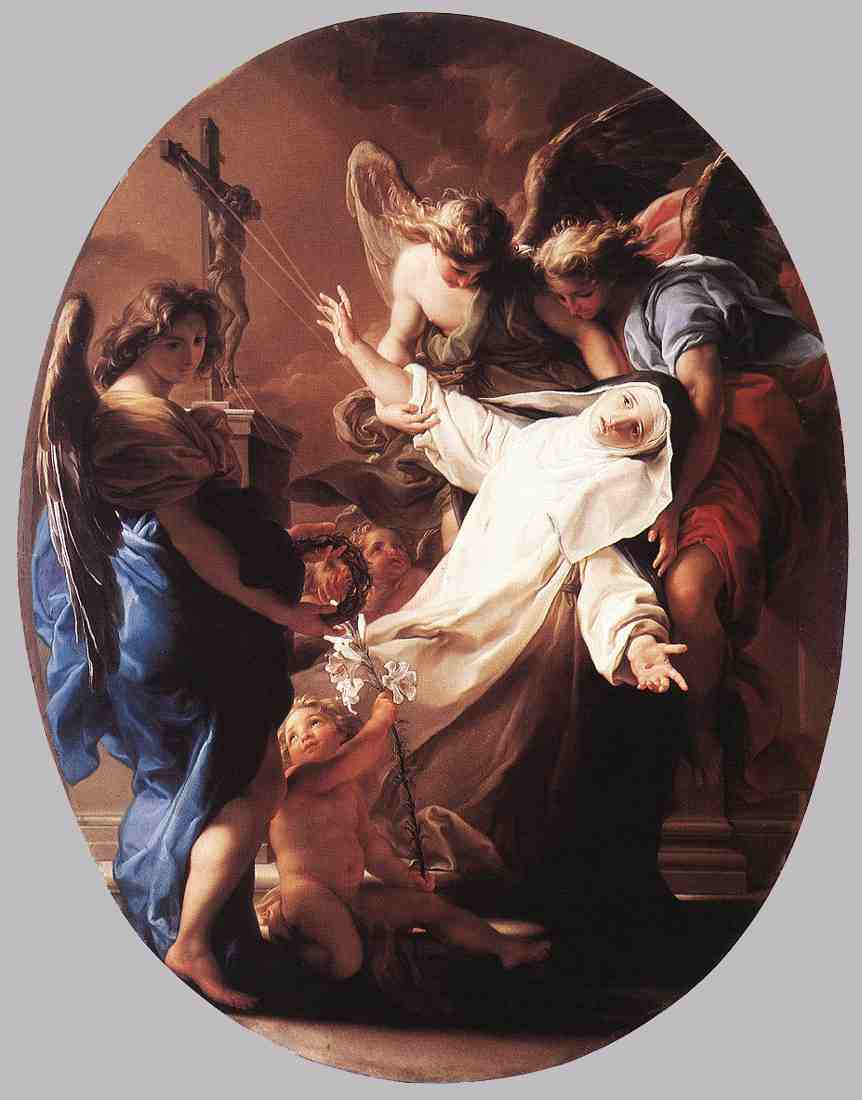
-“The Ecstasy of St Catherine of Siena”, Pompeo Batoni, 1743, Museo di Villa Guinigi, Lucca, Italy
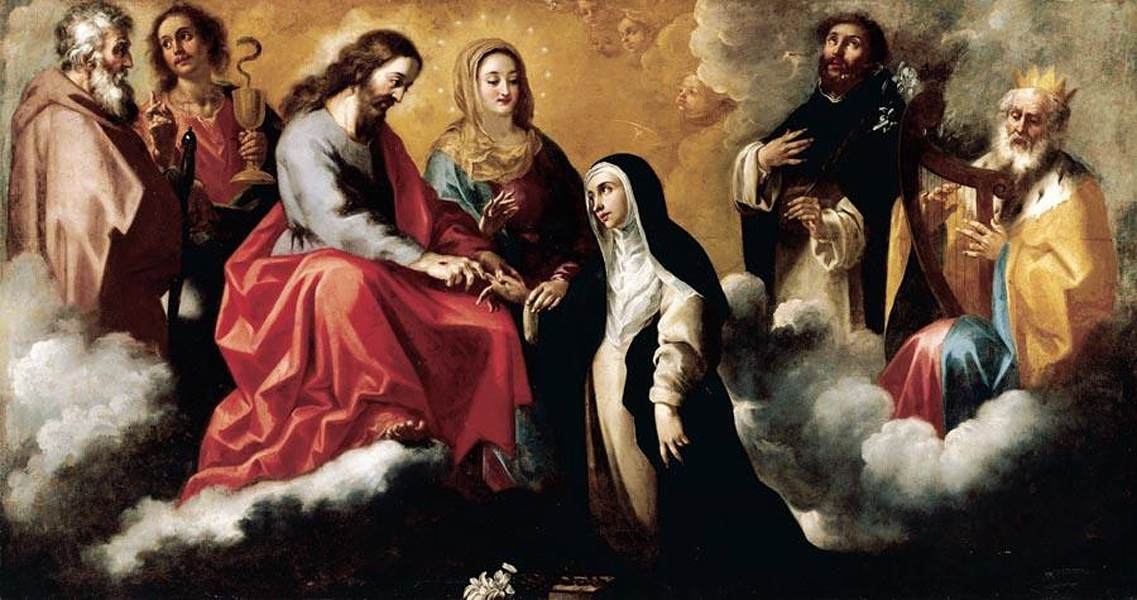
-the mystical marriage of St Catherine of Siena, O.P., Clemente de Torres, ~1715, oil on canvas, H: 175 cm (68.9 in). W: 332 cm (130.7 in), private collection
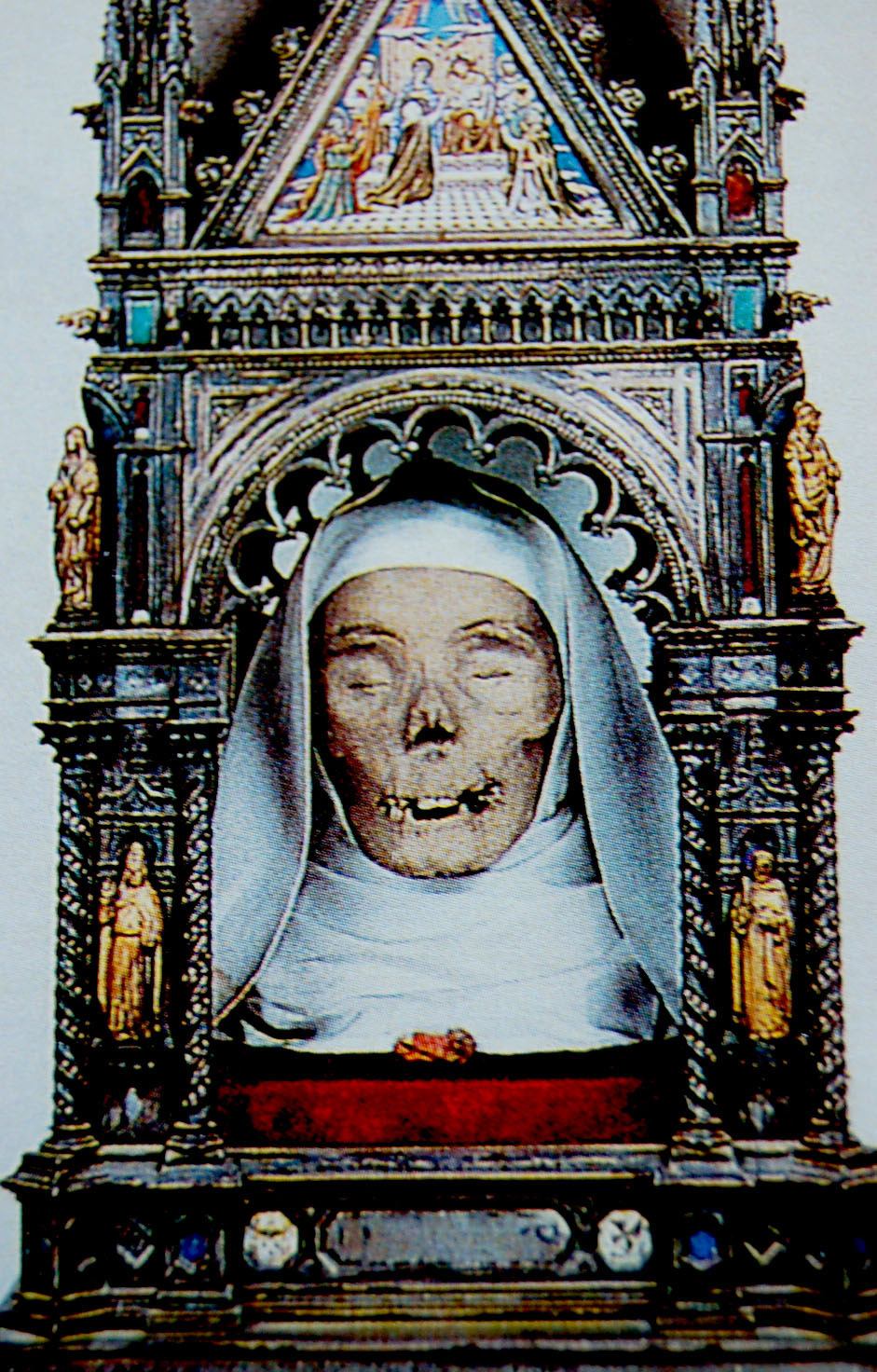
-mummified head of St Catherine of Siena, O.P., Church of San Dominico, Siena
“O eternal Trinity! O fire and abyss of charity! How could our redemption benefit You? It could not, for You, our God, have no need of us. To whom then comes this benefit? Only to man. O inestimable charity! Even as You, true God and true Man, gave Yourself entirely to us, so also You left Yourself entirely for us, to be our food, so that during our earthly pilgrimage we would not faint with weariness, but would be strengthened by You, our celestial Bread. O man, what has your God left you? He has left you Himself, wholly God and wholly Man, concealed under this whiteness of bread. O fire of love! Was it not enough for You to have created us to Your image and likeness, and to have re-created us in grace through the Blood of Your Son, without giving Yourself wholly to us as our Food, O God, Divine Essence? What impelled You to do this? Your charity alone. It was not enough for You to send Your Word to us for our redemption; neither were You content to give Him to us as our Food, but in the excess of Your love for Your creature, You gave to man the whole divine essence. And not only, O Lord, do You give Yourself to us, but by nourishing us with this divine Food, You make us strong with Your power against the attacks of the demons, insults from creatures, the rebellion of our flesh, and every sorrow and tribulation, from whatever source it may come.
O Bread of Angels, sovereign, eternal purity, You ask and want such transparency in a soul who receives You in this sweet Sacrament, that if it were possible, the very angels would have to purify themselves in the presence of such an august mystery. How can my soul become purified? In the fire of Your charity, O eternal God, by bathing itself in the Blood of Your only-begotten Son. O wretched soul of mine, how can you approach such a great mystery without sufficient purification? I will take off, then, the loathsome garments of my will and clothe myself, O Lord, with Your eternal will!” (St. Catherine of Siena).
“Infinite grief I wish from My creature in two ways: in one way, through her sorrow for her own sins, which she has committed against Me her Creator; in the other way, through her sorrow for the sins which she sees her neighbors commit against Me. Of such as these, inasmuch as they have infinite desire, that is, are joined to Me by an affection of love, and therefore grieve when they offend Me, or see Me offended, their every pain, whether spiritual or corporeal, from wherever it may come, receives infinite merit, and satisfies for a guilt which deserved an infinite penalty, although their works are finite and done in finite time; but, inasmuch as they possess the virtue of desire, and sustain their suffering with desire, and contrition, and infinite displeasure against their guilt, their pain is held worthy. Paul explained this when he said: If I had the tongues of angels, and if I knew the things of the future and gave my body to be burned, and have not love, it would be worth nothing to me. The glorious Apostle thus shows that finite works are not valid, either as punishment or recompense, without the condiment of the affection of love.”
—St. Catherine of Siena, The Dialogue
“I’ve appointed the Devil to tempt and to trouble My creatures in this life [St. Catherine of Siena reports that Our Lord said to her]. I’ve done this, not so that My creatures will be overcome, but so that they may overcome, proving their virtue and receiving from Me the glory of victory. And no one should fear any battle or temptation of the Devil that may come to him, because I’ve made My creatures strong, and I’ve given them strength of will, fortified in the Blood of My Son. Neither the Devil nor any other creature can control this free will, because it’s yours, given to you by Me. By your own choice, then, you hold it or let it go if you please. It’s a weapon, and if you place it in the hands of the Devil, it right away becomes a knife that he’ll use to stab and kill you. On the other hand, if you don’t place this knife that is your will into the hands of the Devil—that is, if you don’t consent to his temptations and harassments—you will never be injured by the guilt of sin in any temptation. Instead, you’ll actually be strengthened by the temptation, as long as you open the eyes of your mind to see My love, and to understand why I allowed you to be tempted: so you could develop virtue by having it proved. My love permits these temptations, for the Devil is weak. He can do nothing by himself unless I allow him. So I let him tempt you because I love you, not because I hate you. I want you to conquer, not to be conquered, and to come to a perfect knowledge of yourself and of Me.”
—St. Catherine of Siena
“Very pleasing to Me, dearest daughter, is the willing desire to bear every pain and fatigue, even unto death, for the salvation of souls, for the more the soul endures, the more she shows that she loves Me; loving Me she comes to know more of My truth, and the more she knows, the more pain and intolerable grief she feels at the offenses committed against me.”
—God to St. Catherine of Siena, Dialogue
“I will first, dearest daughter, speak to thee of the dignity of priests, having placed them where they are through My goodness, over and above the general love which I have had to My creatures, creating you in My image and likeness and re-creating you all to the life of grace in the Blood of My Only-begotten Son, whence you have arrived at such excellence, through the union which I made of My Deity with human nature; so that in this you have greater dignity and excellence than the angels, for I took your human nature and not that of the angels. Wherefore, as I have said to you, I, God, have become man, and man has become God by the union of My Divine Nature with your human nature. This greatness is given in general to all rational creatures, but, among these I have especially chosen My ministers for the sake of your salvation, so that, through them, the Blood of the humble and immaculate Lamb, My Only-begotten Son, may be administered to you.”
—St. Catherine Of Siena, Dialogue
“Consider that the love of divine charity is so closely joined in the soul with perfect patience, that neither can leave the soul without the other. For this reason (if the soul elect to love Me) she should elect to endure pains for Me in whatever mode or circumstance I may send them to her. Patience cannot be proved in any other way than by suffering, and patience is united with love as has been said. Therefore bear yourselves with manly courage, for, unless you do so, you will not prove yourselves to be spouses of My Truth, and faithful children, nor of the company of those who relish the taste of My honor, and the salvation of souls.”
—St. Catherine Of Siena, Dialogue
“I do not wish the soul to consider her sins, either in general or in particular, without also remembering the Blood and the broadness of My mercy, for fear that otherwise she should be brought to confusion. And together with confusion would come the devil, who has caused it, under color of contrition and displeasure of sin, and so she would arrive at eternal damnation, not only on account of her confusion, but also through the despair which would come to her, because she did not seize the arm of My mercy. This is one of the subtle devices with which the Devil deludes My servants, and, in order to escape from his deceit, and to be pleasing to Me, you must enlarge your hearts and affections in My boundless mercy, with true humility. You know that the pride of the Devil cannot resist the humble mind, nor can any confusion of spirit be greater than the broadness of My good mercy, if the soul will only truly hope therein.”
—St. Catherine Of Siena
“Know, dearest daughter, how, by humble, continual, and faithful prayer, the soul acquires, with time and perseverance, every virtue. Wherefore should she persevere and never abandon prayer… The soul should advance by degrees, and I know well that, just as the soul is at first imperfect and afterwards perfect, so also is it with her prayer. She should nevertheless continue in vocal prayer, while she is yet imperfect, so as not to fall into idleness. But she should not say her vocal prayers without joining them to mental prayer, that is to say, that while she is reciting, she should endeavor to elevate her mind in My love, with the consideration of her own defects and of the Blood of My only-begotten Son, wherein she finds the breadth of My charity and the remission of her sins.”
—St. Catherine Of Siena, Dialogue
“He will provide the way and the means, such as you could never have imagined. Leave it all to Him, let go of yourself, lose yourself on the Cross, and you will find yourself entirely.”
–St. Catherine of Siena
“To join two things together there must be nothing between them or there cannot be a perfect fusion. Now realize that this is how God wants our soul to be, without any selfish love of ourselves or of others in between, just as God loves us without anything in between.”
–St. Catherine of Siena
Love Undefiled
Eternal God, eternal Trinity,
You have made the Blood of Christ so precious
through His sharing in Your Divine nature.
You are a mystery as deep as the sea;
the more I search, the more I find,
and the more I find the more I search for You.
But I can never be satisfied;
what I receive will ever leave me desiring more.
When You fill my soul I have an ever-greater hunger,
and I grow more famished for Your light.
I desire above all to see You,
the true light, as you really are.
Amen.
-St Catherine of Siena
“Very pleasing to Me, dearest daughter, is the willing desire to bear every pain and fatigue, even unto death, for the salvation of souls, for the more the soul endures, the more she shows that she loves Me; loving Me she comes to know more of My truth, and the more she knows, the more pain and intolerable grief she feels at the offenses committed against Me.”
—God to St. Catherine of Siena in the book, Dialogue of St. Catherine of Siena
PRAYER TO BE ATTENTIVE TO GOD’S LOVE
“Eternal Goodness, you want me to gaze into You and see that You love me, to see that You love me gratuitously, so that I may love everyone with the very same love. You want me, then, to love and serve my neighbors gratuitously, by helping them spiritually and materially as much as I can, without any expectation of selfish profit or pleasure. Nor do You want me to hold back because of their ingratitude or persecution, or for any abuse I may suffer from them. What then shall I do to come to such a vision? I shall strip myself of my stinking garment, and by the light of my holy faith I shall contemplate myself in You. And I shall clothe myself in Your eternal will.” -Saint Catherine of Siena
Addressing the God the Father, Saint Catherine of Siena said in her Dialogue, “I am she who is not. . . . You alone are He Who is; my being and every other grace that you have given me beyond my being I have from You, which you gave and give to me through love, and not because it was owed to me.” (Ch. 134)
Love,
Matthew
Apr 5 – St Vincent Ferrer, O.P., (1350-1419), “Angel of the Last Judgment”, Great Catholic Reformer, Patron of Reconciliation
The polarization in the Church today is a mild breeze compared with the tornado that ripped the Church apart during the lifetime of this saint. If any saint is a patron of reconciliation, St. Vincent Ferrer, OP, is. Born in Valencia, Spain, January 23, 1350, the fourth child and second son of William Ferrer and Constantia Miguel, and named in honor of St Vincent Martyr, patron of Valencia, whom we considered back in January of this year.
Vincent’s birth was anything but a quiet affair! It is said that his mother, who was accustomed to difficult pregnancies, experienced only an indescribable goodness and joy at the birth of her son. This experience was accompanied by Vincent’s father’s dream in which a Dominican friar announced to him that his son would one day enter the Order of Preachers and his fame would spread throughout the world. A poor blind woman, when giving thanks to the mother of the saint for alms, astounded her by prophesying, “O happy mother, it is an angel that you bear, and one day he will give me my sight!” It is recorded that the woman did receive her sight.
Despite parental opposition, Vincent Ferrer entered the Dominican Order in his native Spain at 19. After brilliant studies, he was ordained a priest by Cardinal Peter de Luna—who would figure tragically in his life.
Contemporary evidence pictures St. Vincent Ferrer to have been a man of medium height, with a lofty forehead and very distinct features that seemed to inspire a sense of reverence and awe in all who knew him. His hair was fair in color and shaven in the form of a monastic tonsure, which is said to have resembled an areola of glory around his head. His eyes were very dark, very expressive, and full of fire, which were tempered, however, by his ever gentle manner. Pale as was his ordinary color, it is said that he became slightly ruddy when preaching. Although his handsomeness faded in later years as a result of his arduous labors and the austerities that he practiced, it became changed rather than vanished. His countenance took on a transparent peacefulness or glow that seemed to be the reflection of the inward beauty of his great spirit that was aflame with the love of God and of his neighbor. His voice was strong and powerful, at times gentle, resonant, and vibrant as it seemed to search deeply the heart and to inspire fear when fear was needed and to soothe with exquisite tenderness when comfort was needed.
Of a very ardent nature, Vincent practiced the austerities of his Order with great energy. He was chosen prior of the Dominican house in Valencia shortly after his ordination. During a severe fever in 1398, Vincent had a vision of Christ, Saint Dominic de Guzman and Saint Francis of Assisi. It was a life changing experience – Vincent received supernatural gifts and he believed that he was instructed in his vision to be a messenger of penance, an “angel of the apocalypse” sent to prepare humankind for the Judgment of Christ.
St. Vincent Ferrer was a great preacher who converted thousands in Spain, France, Italy, Germany, the Netherlands, England, Scotland, and Ireland. He was invited to preach in Muslim Granada. He slept on the floor, had the gift of tongues (he spoke only Spanish, but all listeners understood him), lived in an endless fast, celebrated Mass daily, and was known as a miracle worker – reported to have brought a murdered man back to life to prove the power of Christianity to the onlookers, and he would heal people throughout a hospital just by praying in front of it. He worked so hard to build up the Church that he became the patron of people in building trades.
The Great Western Schism (1378-1417) divided Christianity first between two, then three, popes. Clement VII lived at Avignon in France, Urban VI in Rome. Vincent was convinced the election of Urban was invalid (though St. Catherine of Siena was just as devoted a supporter of the Roman pope). In the service of Cardinal de Luna, he worked to persuade Spaniards to follow Clement. When Clement died, Cardinal de Luna was elected at Avignon and became Benedict XIII.
At the beginning of the 14th century, following a disagreement between Pope Boniface VIII and King Philip the Fair(handsome) of France, who was immorally ambitious, a French pope, Clement V, was elected. Within four years, civil unrest in Rome and riots between rival factions drove Clement V to take shelter with the Dominican order in Avignon. The move was intended to be temporary, but a number of factors combined to make it a longer sojourn. Known as the “Babylonian Captivity” of the papacy, the schism was eventually resolved by the Council of Constance (1414-1418). Cardinals from both sides had previously met at Pisa in 1409, and trying to end the schism, elected a third pope. The rift was not healed until the Council of Constance vacated all three seats and elected Martin V as pope in 1417.
Vincent worked for his friend, Benedict XIII, as apostolic penitentiary and Master of the Sacred Palace in Avignon. But the new pope did not resign as all candidates in the conclave had sworn to do. Benedict XIII remained stubborn despite being deserted by the French king and nearly all of the cardinals.
Vincent became disillusioned with his friend and church politics in general, and also very ill, but finally took up the work of simply “going through the world preaching Christ,” though he felt that any renewal in the Church depended on healing the schism. An eloquent and fiery preacher, he spent the last 20 years of his life spreading the Good News in Spain, France, Switzerland, the Low Countries and Lombardy, stressing the need of repentance and the fear of coming judgment. (He became known as the “Angel of the Judgment.”)
He tried, again, unsuccessfully, in 1408 and 1415, to persuade his former friend to resign. He finally concluded that Benedict was not the true pope. Though very ill, he mounted the pulpit before an assembly over which Benedict himself was presiding and thundered his denunciation of the man who had ordained him a priest. Benedict fled for his life, abandoned by those who had formerly supported him. Strangely, Vincent had no part in the Council of Constance, which ended the schism.
The split in the Church at the time of St Vincent Ferrer, OP, should have been fatal—36 long years of having two “heads.” We cannot imagine what condition the Church today would be in if, for that length of time, half the world had followed a succession of popes in Rome, and half, an equally “official” number of popes in, say, Rio de Janeiro. It is an ongoing miracle that the Church has not long since been shipwrecked on the rocks of pride and ignorance, greed and ambition. Contrary to Lowell’s words, “Truth forever on the scaffold, wrong forever on the throne,” we believe that “truth is mighty, and it shall prevail”—but it sometimes takes a long time.
“Precious stone of virginity…
Flaming torch of charity…
Mirror of penance…
Trumpet of eternal salvation…
Flower of heavenly wisdom…
Vanquisher of demons.”
(-from the litanies of St. Vincent Ferrer, O.P.)
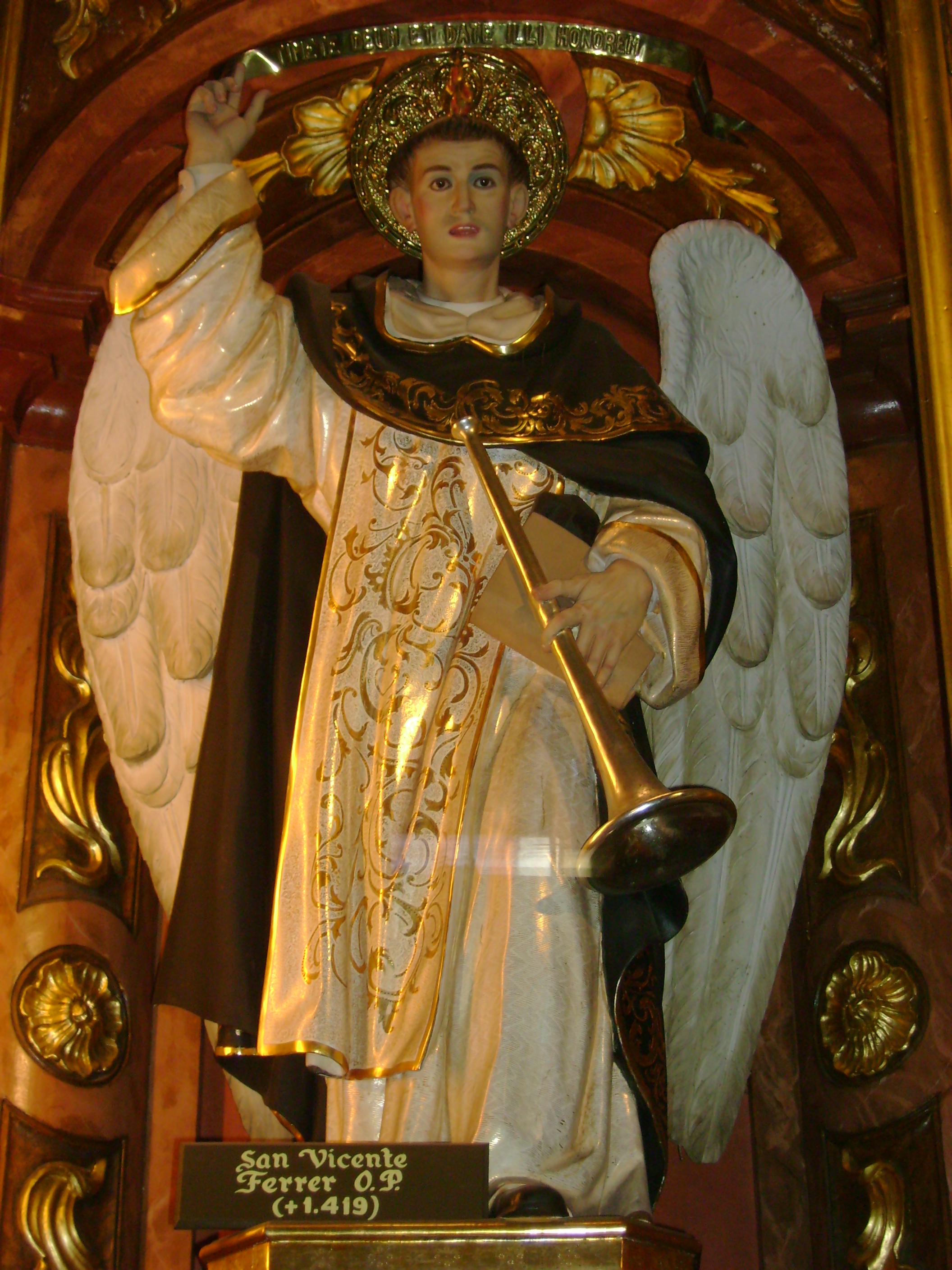
-please click on the image for greater detail
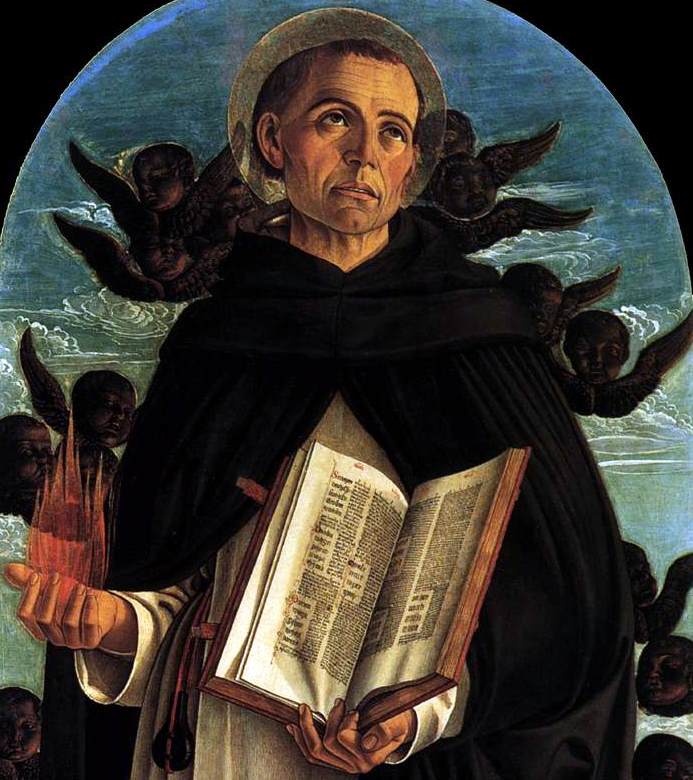
-Polytptych Vicente Ferrer, by Giovanni Bellini, 1465, Santi Giovanni e Paolo, Venice, please click on the image for greater detail
ribbon reads “Timete Deum Et Date Illi Honorem” – “Fear God and give Him honor!” – Rev. 14:7
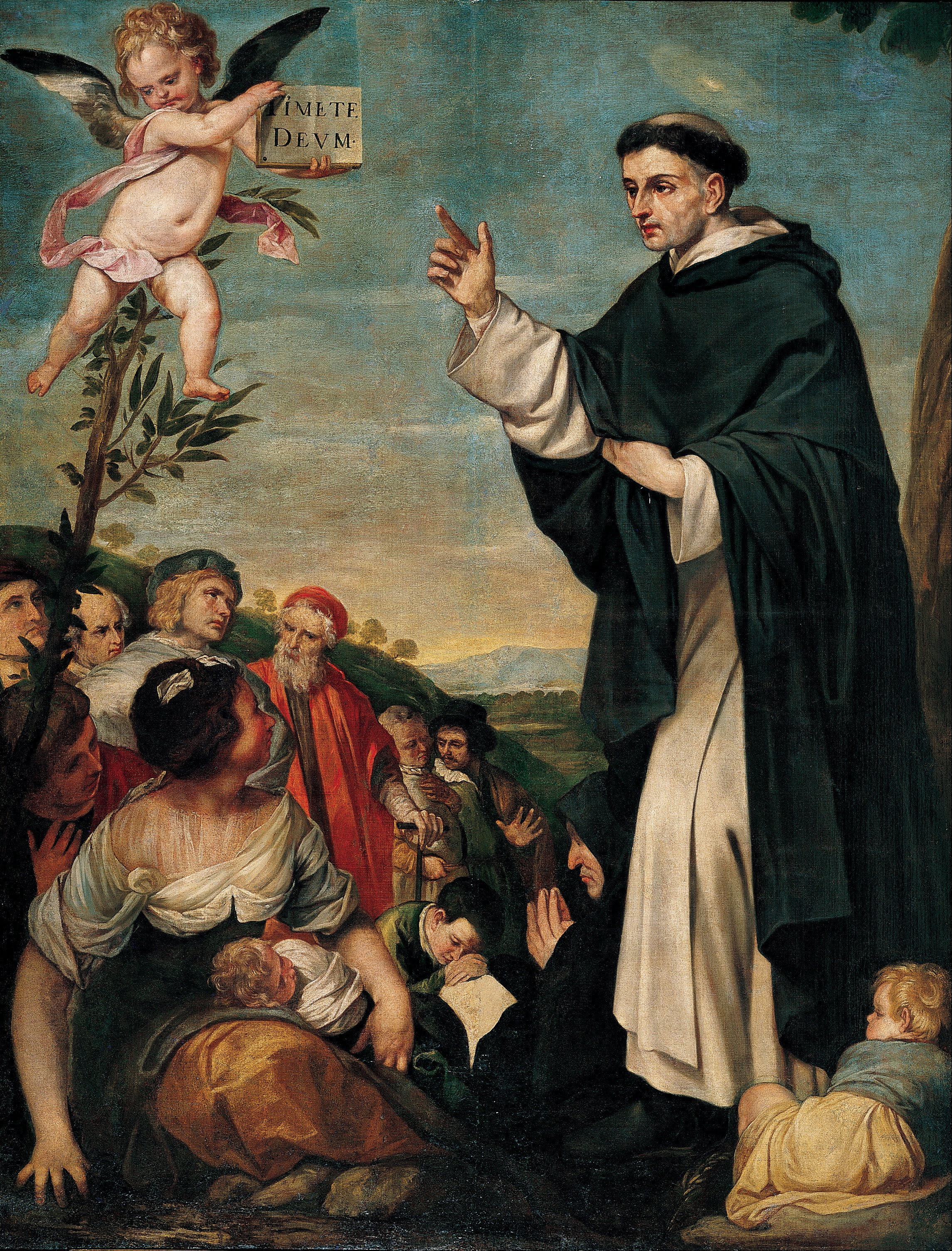 –“Saint Vincent Ferrer Preaching with Angel Holding a Banner that reads “FEAR GOD” by Alonzo Cano (1601-1667); 1644-45; Fundación Banco Santander, Madrid, Spain, oil on canvas, height: 2,140 mm (84.25 ″); width: 1,640 mm (64.56 ″) please click on the image for greater detail
–“Saint Vincent Ferrer Preaching with Angel Holding a Banner that reads “FEAR GOD” by Alonzo Cano (1601-1667); 1644-45; Fundación Banco Santander, Madrid, Spain, oil on canvas, height: 2,140 mm (84.25 ″); width: 1,640 mm (64.56 ″) please click on the image for greater detail
“The Lord sends us tribulations and infirmities to give us the means of paying the immense debts we have contracted with Him. Therefore, those who have good sense receive them joyfully, for they think more of the good which they may derive from them than of the pain which they experience on account of them.” -St Vincent Ferrer, OP
“If you truly want to help the soul of your neighbor, you should approach God first with all your heart. Ask Him simply to fill you with charity, the greatest of all virtues; with it you can accomplish what you desire.”
–St. Vincent Ferrer, OP
“A person who has a director by whom he allows himself to be guided . . . will more easily and quickly arrive at perfection than he ever could by himself.”
-St Vincent Ferrer, OP
“A vain question deserves nothing but silence. So learn to be silent for a time; you will edify your brethren and silence will teach you to speak when the hour is come.”
-St. Vincent Ferrer, OP
“Consult God more than your books, and ask Him, with humility, to make you understand what you read.”
-St. Vincent Ferrer
Prayer
O my protector, St. Vincent Ferrer, as the eternal God has deposited in you an inexhaustible treasurer of grace and of supernatural virtues, hear my earnest petition, and help me with your intercession, more powerful now even than when you were on earth. Hence with blind confidence do I cast myself at your feet, there to place my requests for all those in whom I am concerned but more particularly for (special favor). O glorious saint, let not my confidence in you be deceived. Present for me, to the Divine Majesty, your suppliant prayers and watch over my soul. Should sorrow and trials increase, so also will my rejoicing increase, and may my patience grow with each day, that I may thus save my soul. Amen.
Love,
Matthew
Apr 9 – St Casilda of Toledo, Virgin, (d. 1050 AD), Convert from Islam

-another image of St Casilda of Toledo by Zuraban
St. Casilda was the daughter of a Muslim leader called Almacrin or Almamun in Toledo, Spain, in the 10th century. Casilda was herself raised as a Muslim and showed special kindness to Christian prisoners, carrying bread to them hidden in her clothes. Once, she was stopped by Muslim soldiers and asked to reveal what she was carrying in her skirt. When she began to show them, the bread turned into a bouquet of roses.
Casilda became ill as a young woman but was not convinced that any of the local Arab doctors could cure her. So, she made a pilgrimage to the shrine of San Vicenzo (Saint Vincent Martyr, whom we considered in January) in northern Spain. Like so many other people who made their way there—many of them suffering from hemorrhages—Casilda sought the healing waters of the shrine. We’re uncertain what illness brought her to the shrine, but we do know that she left it relieved of illness.
In response, she became a Christian and lived a life of solitude and penance not far from the miraculous spring. It’s said that she lived to be 100 years old. Her death likely occurred around the year 1050.

-St Casilda of Toledo by Francisco de Zuraban, ~1640
Love,
Matthew


